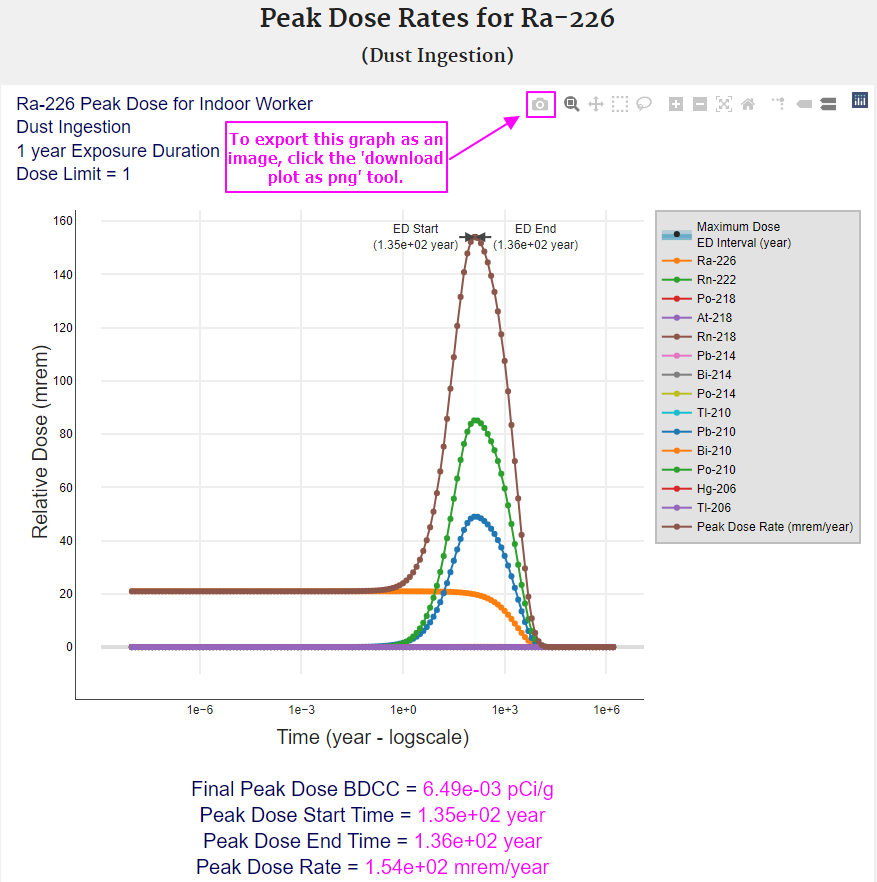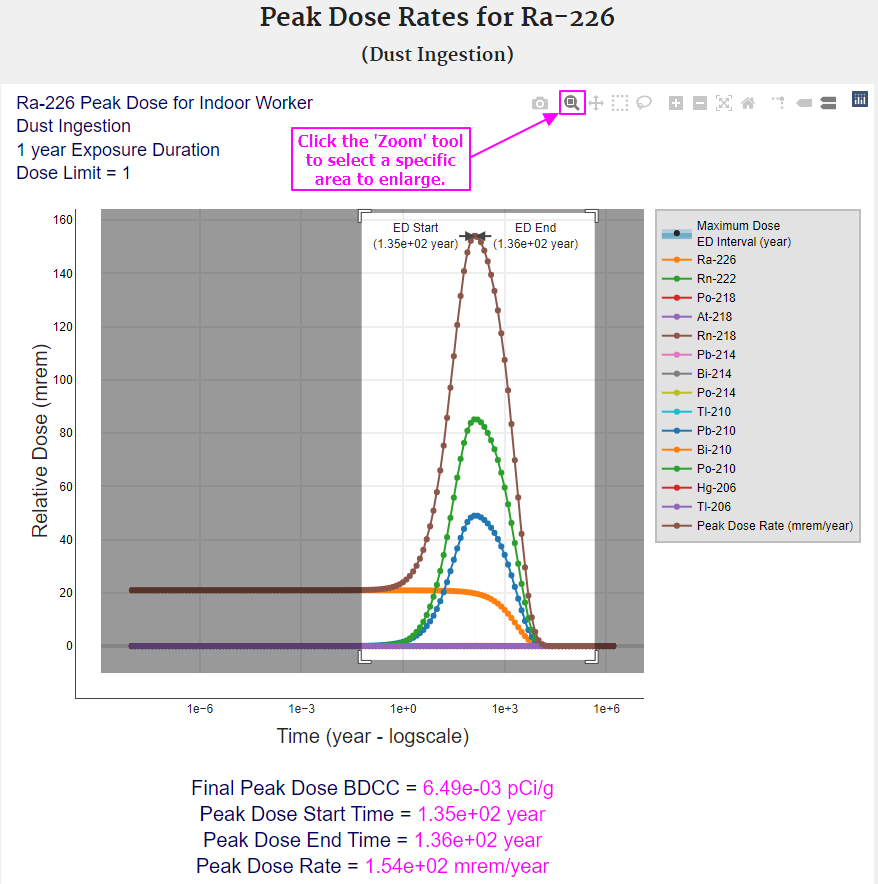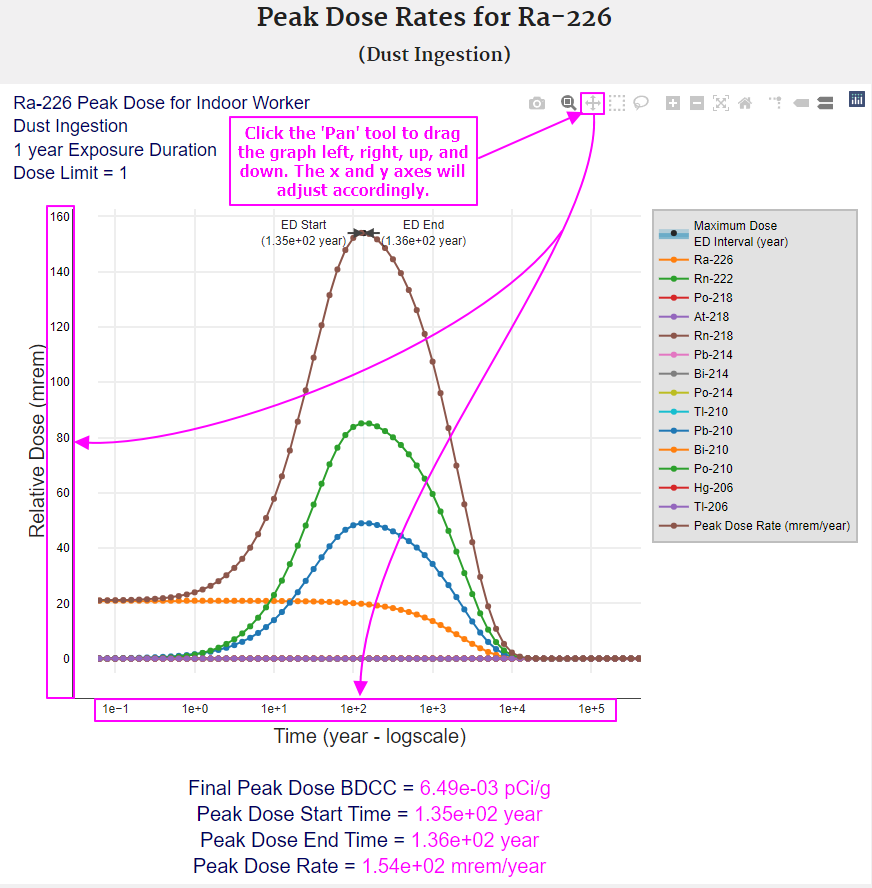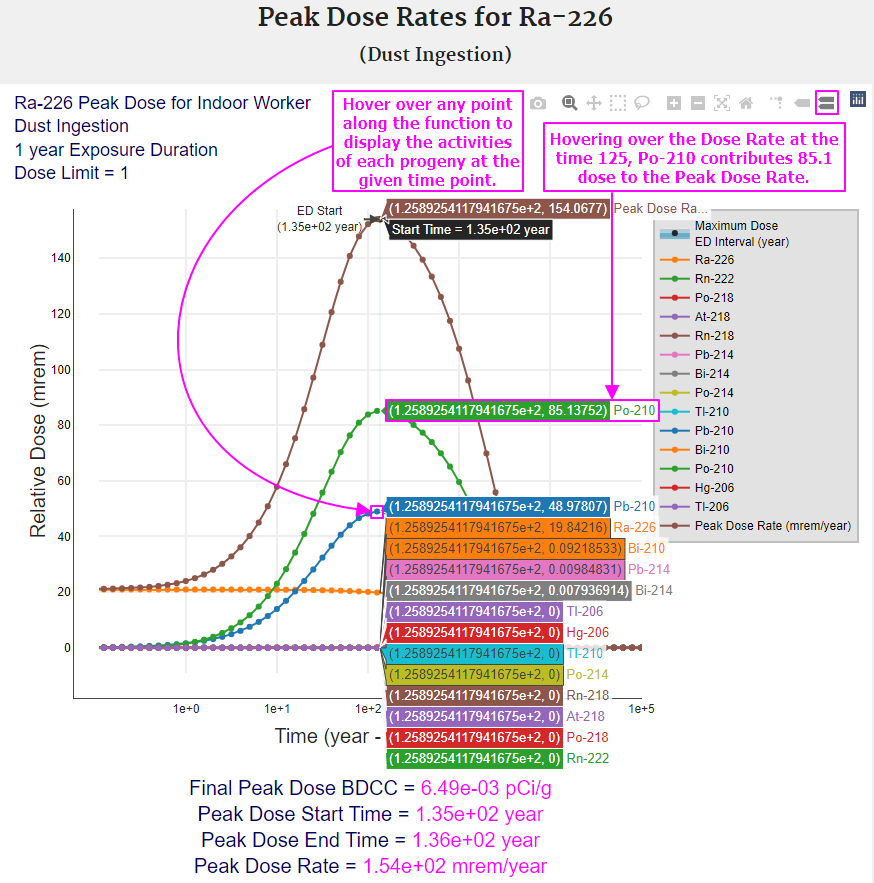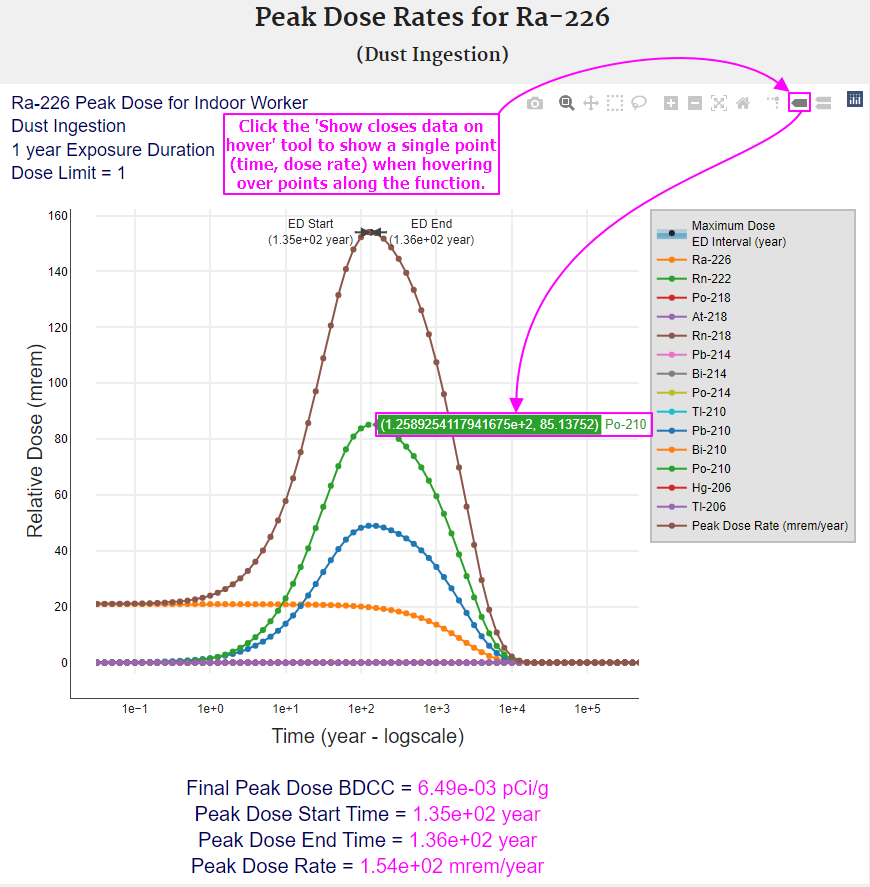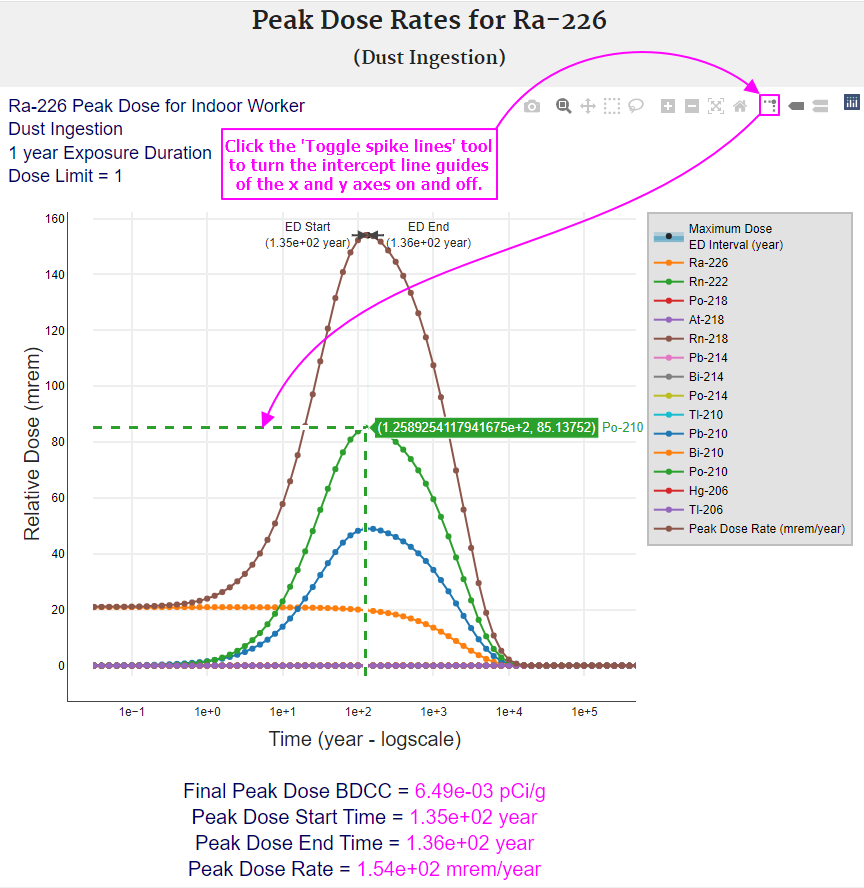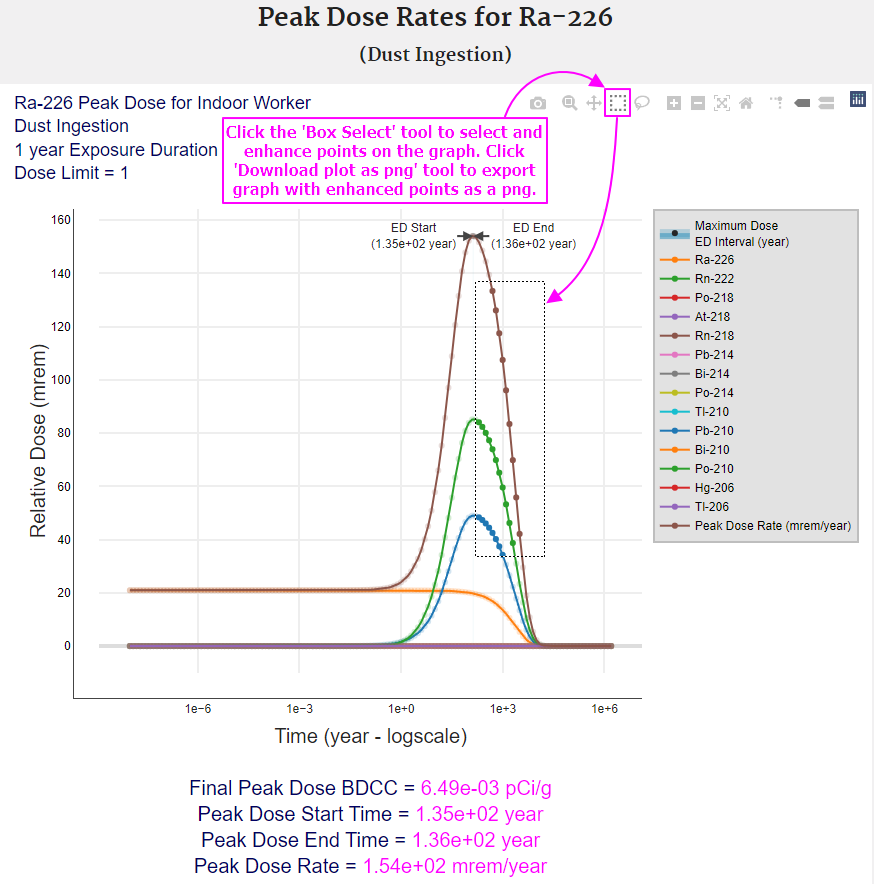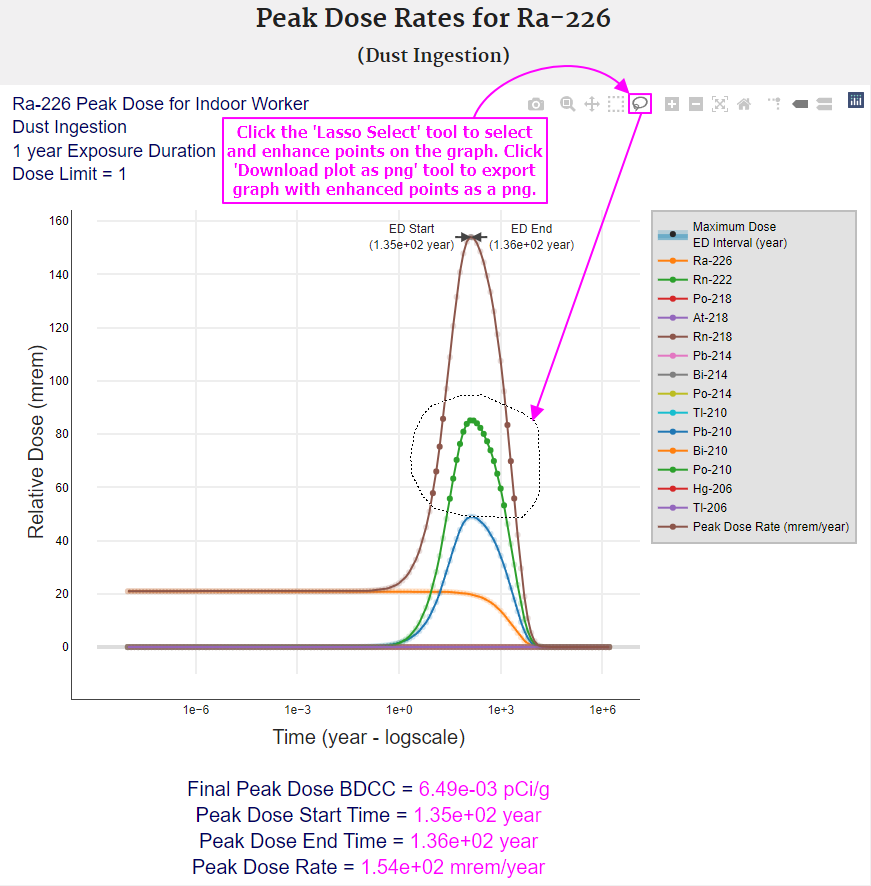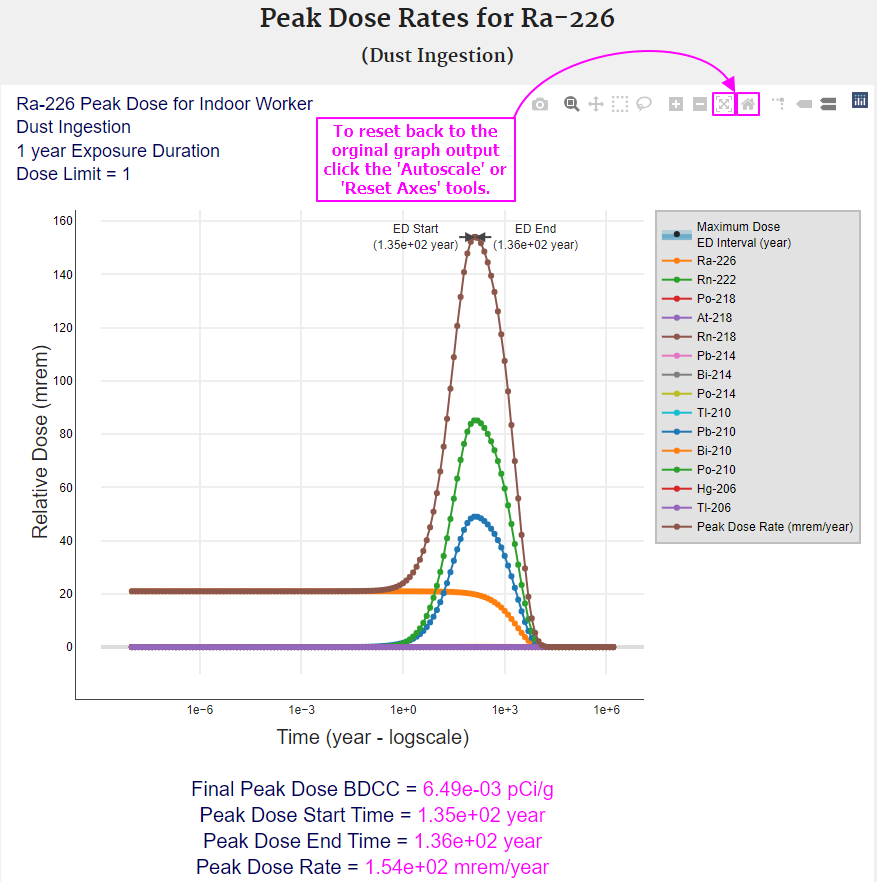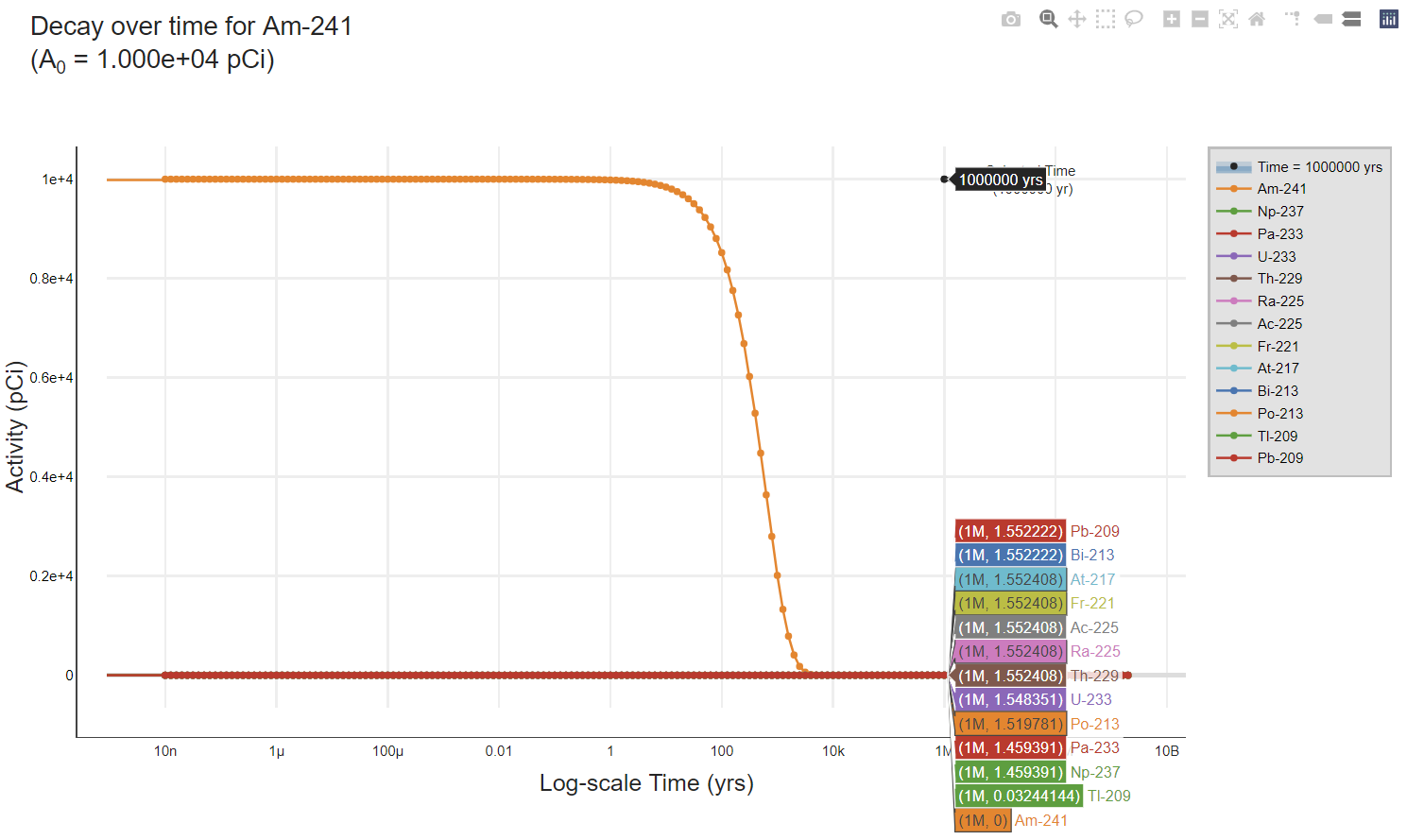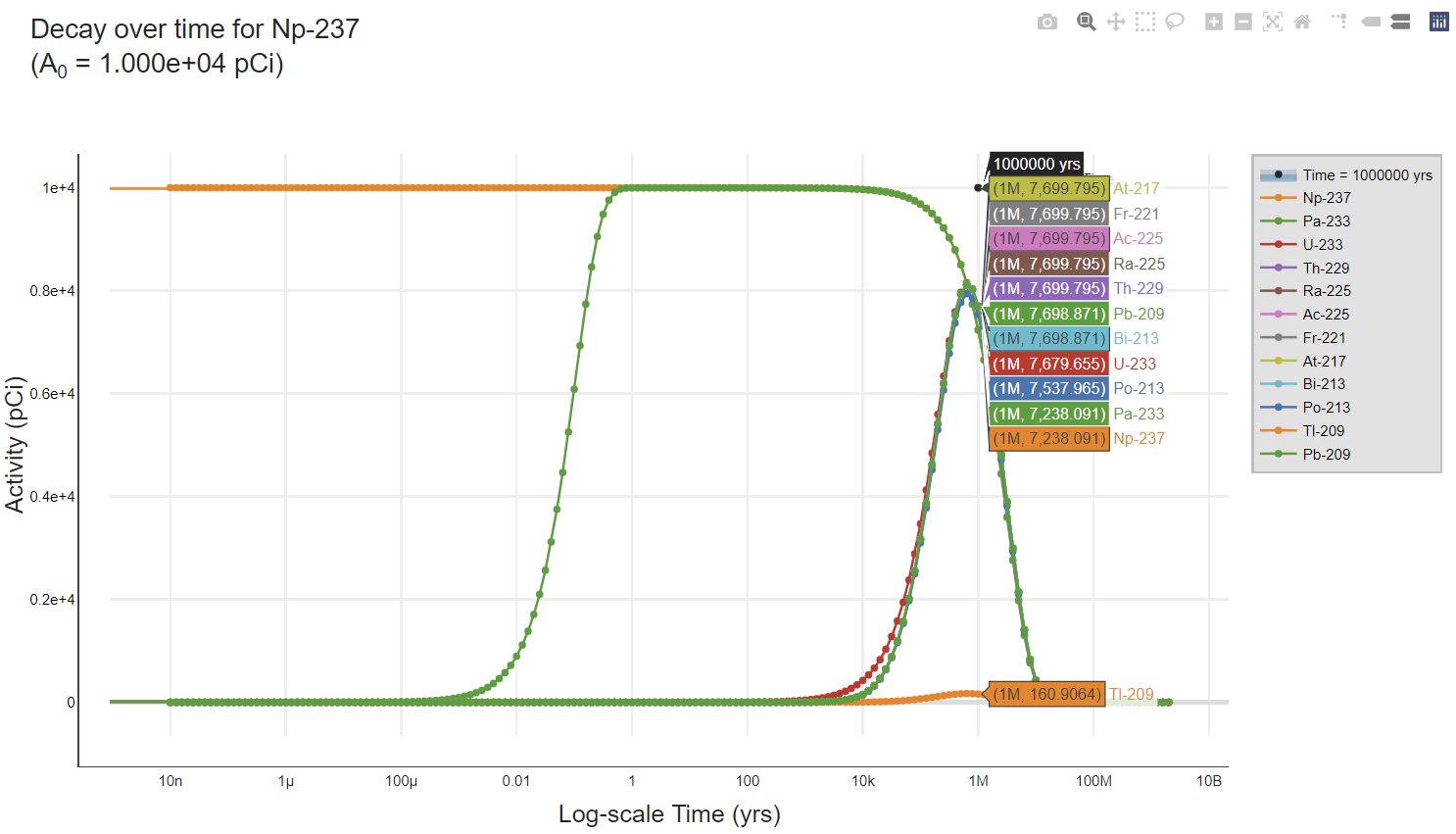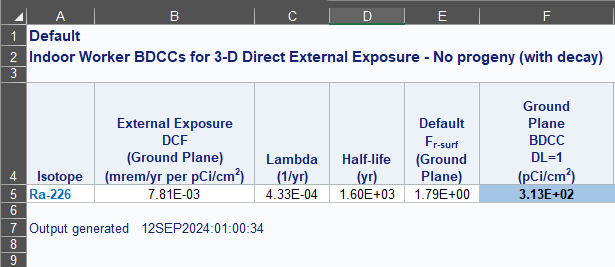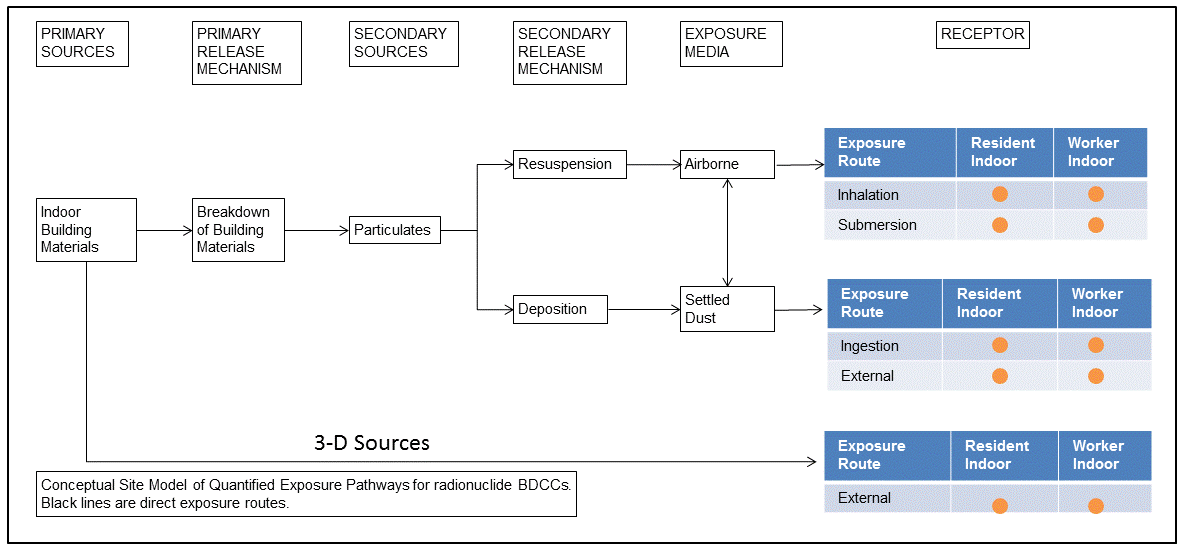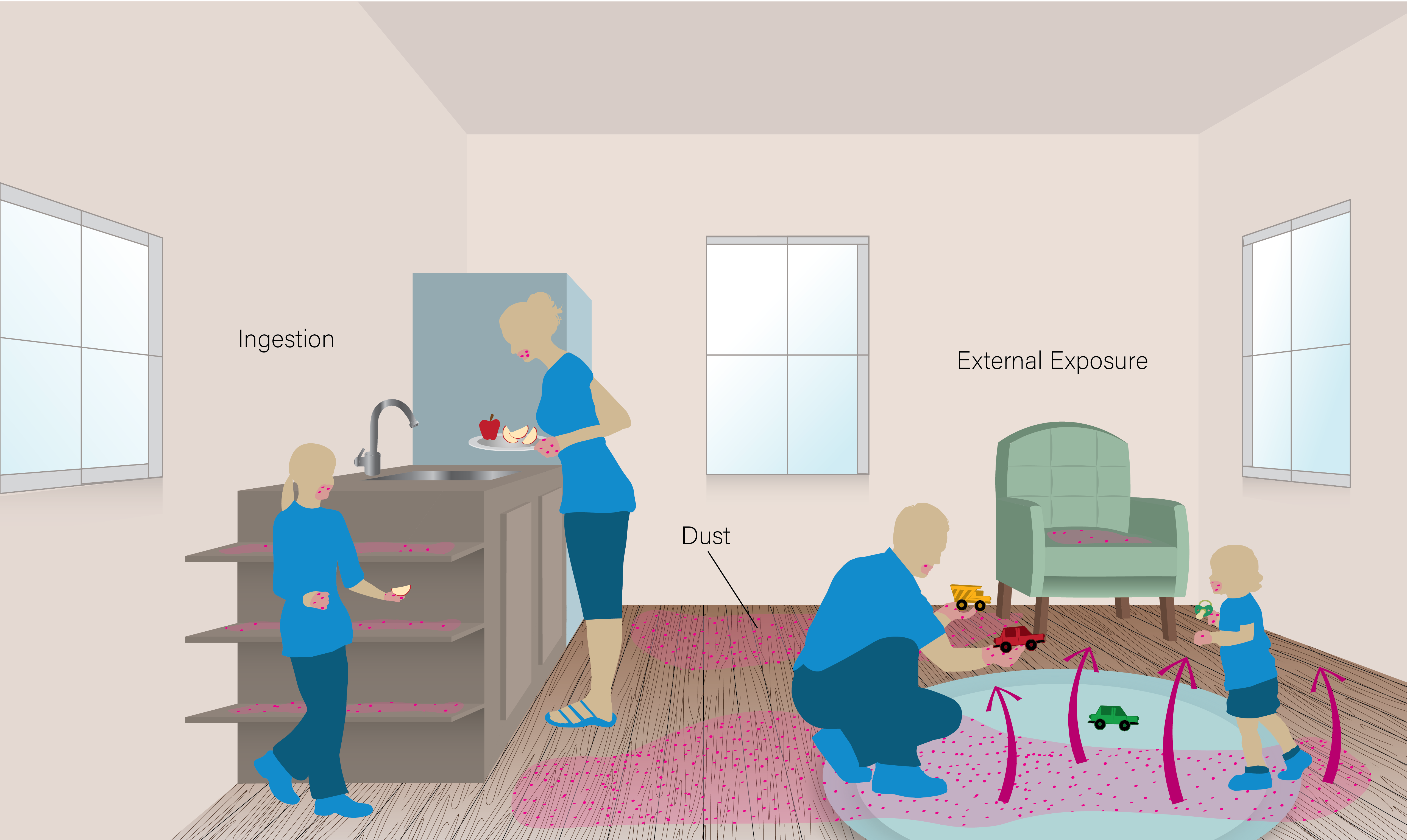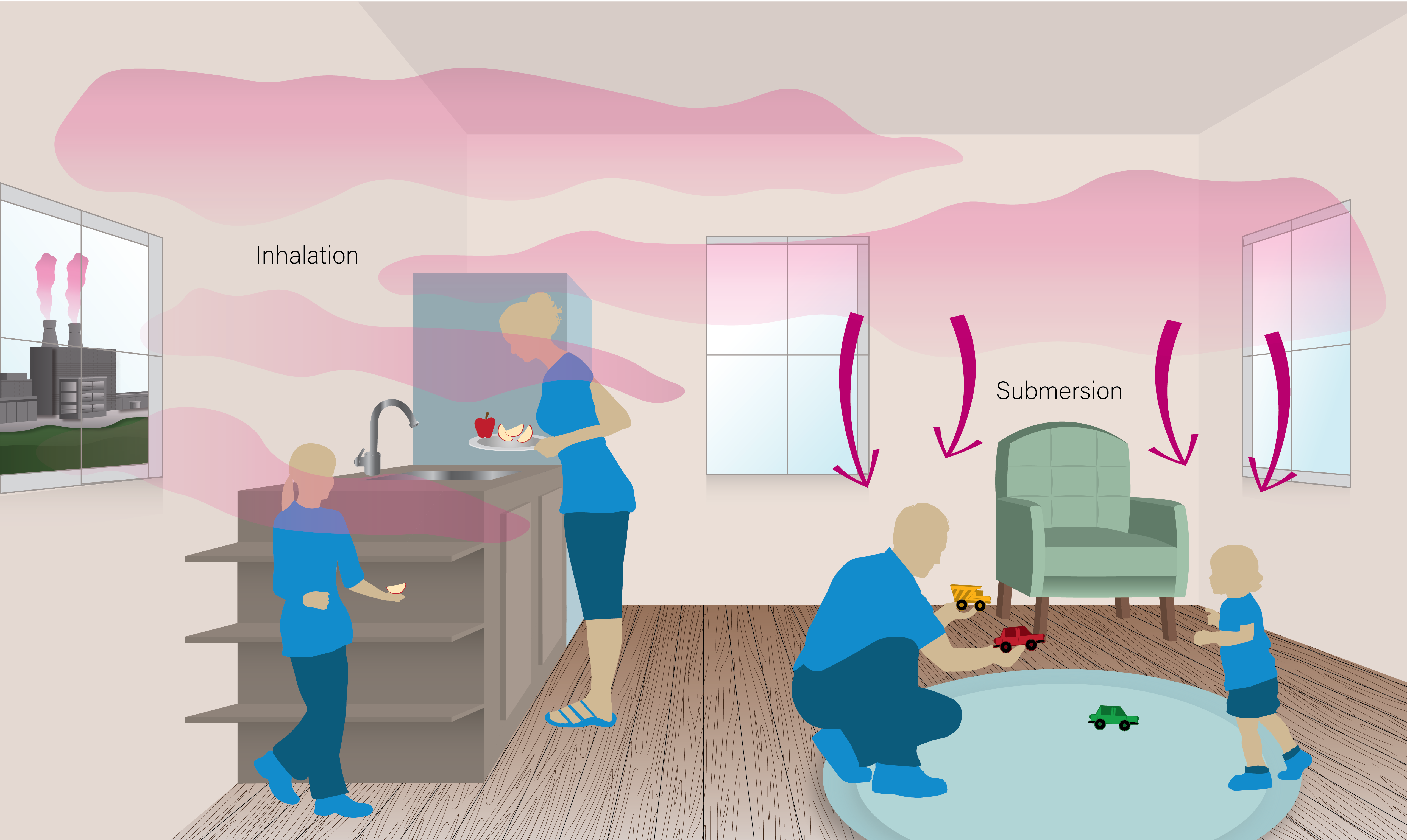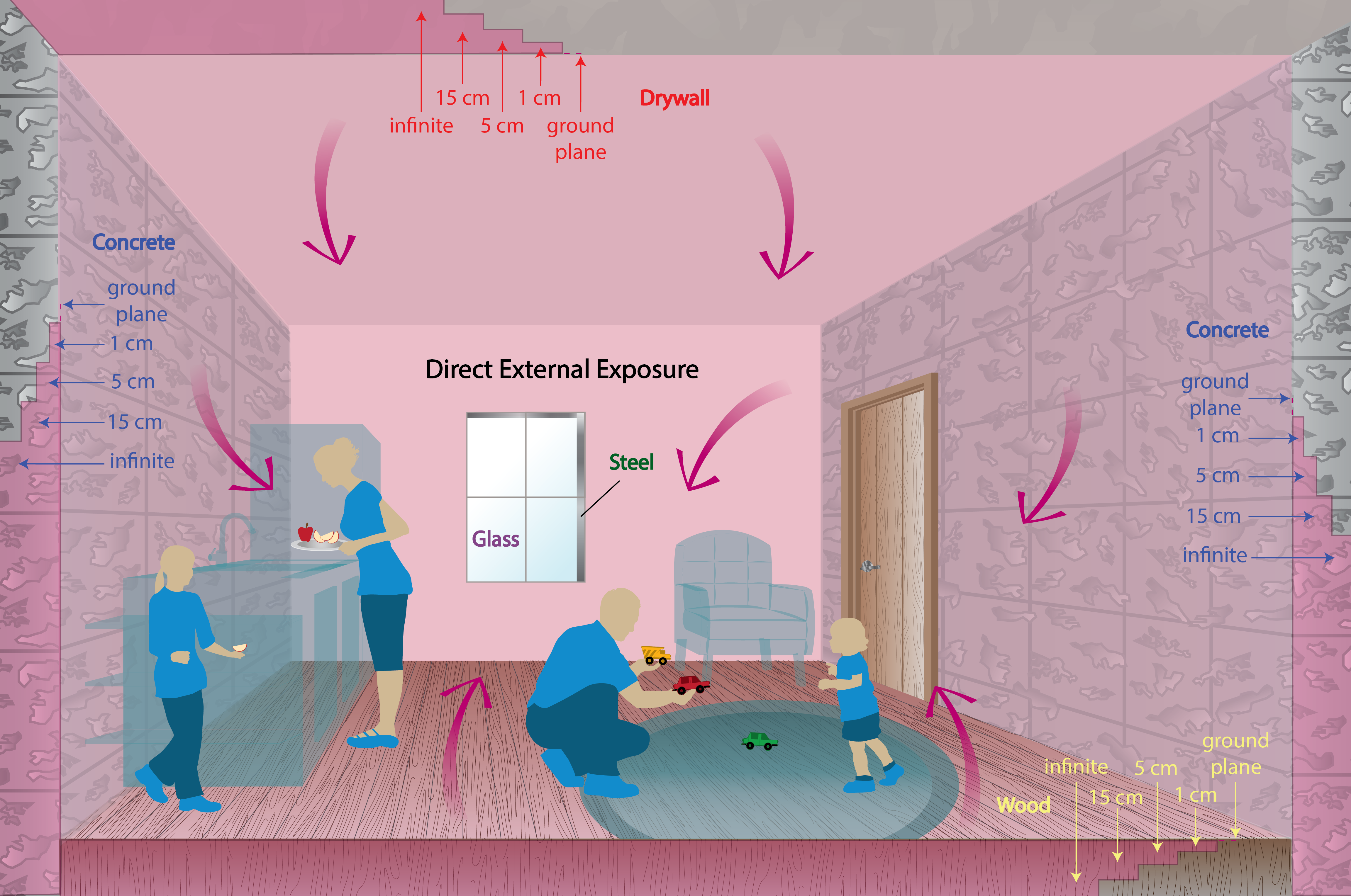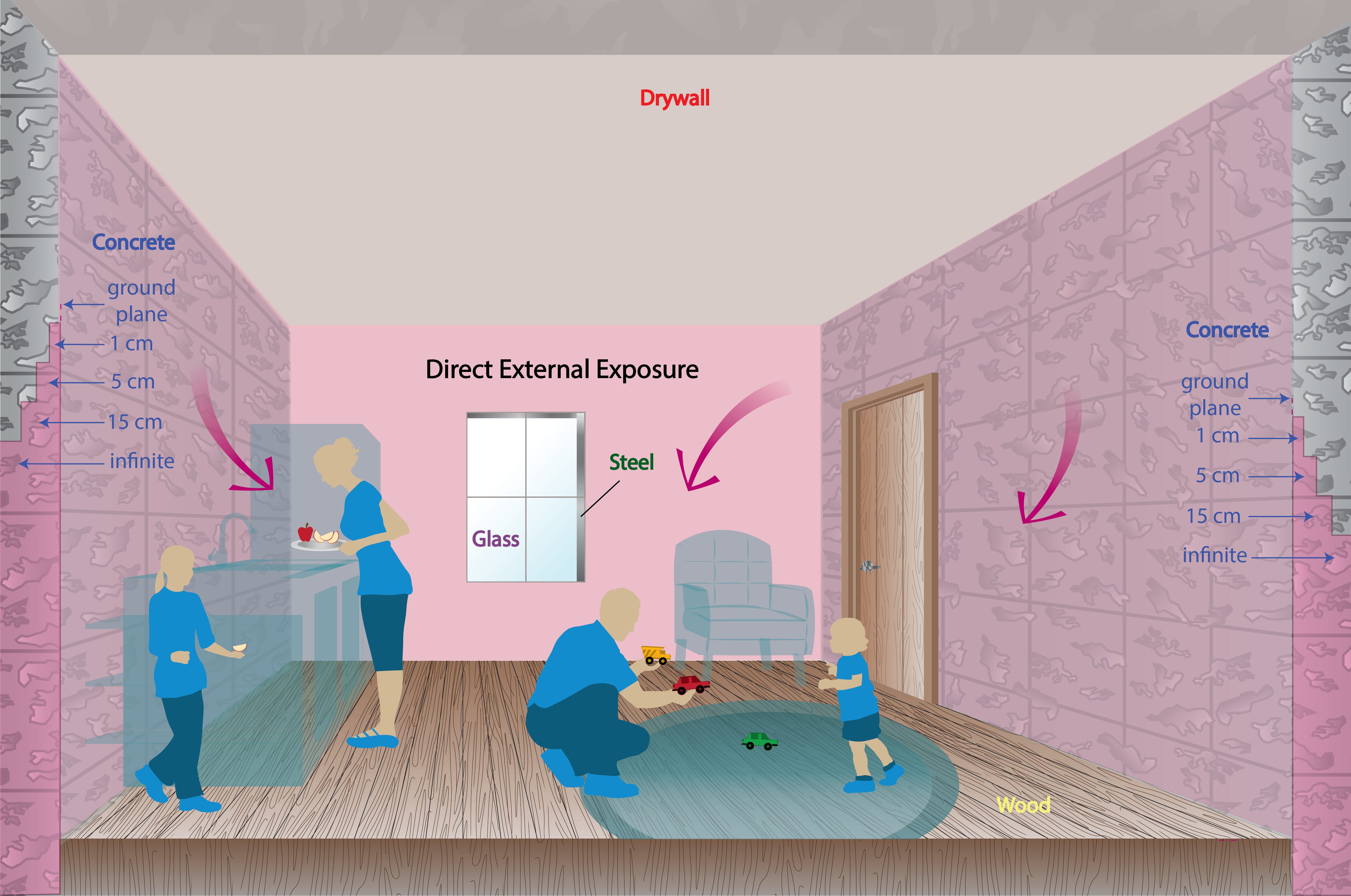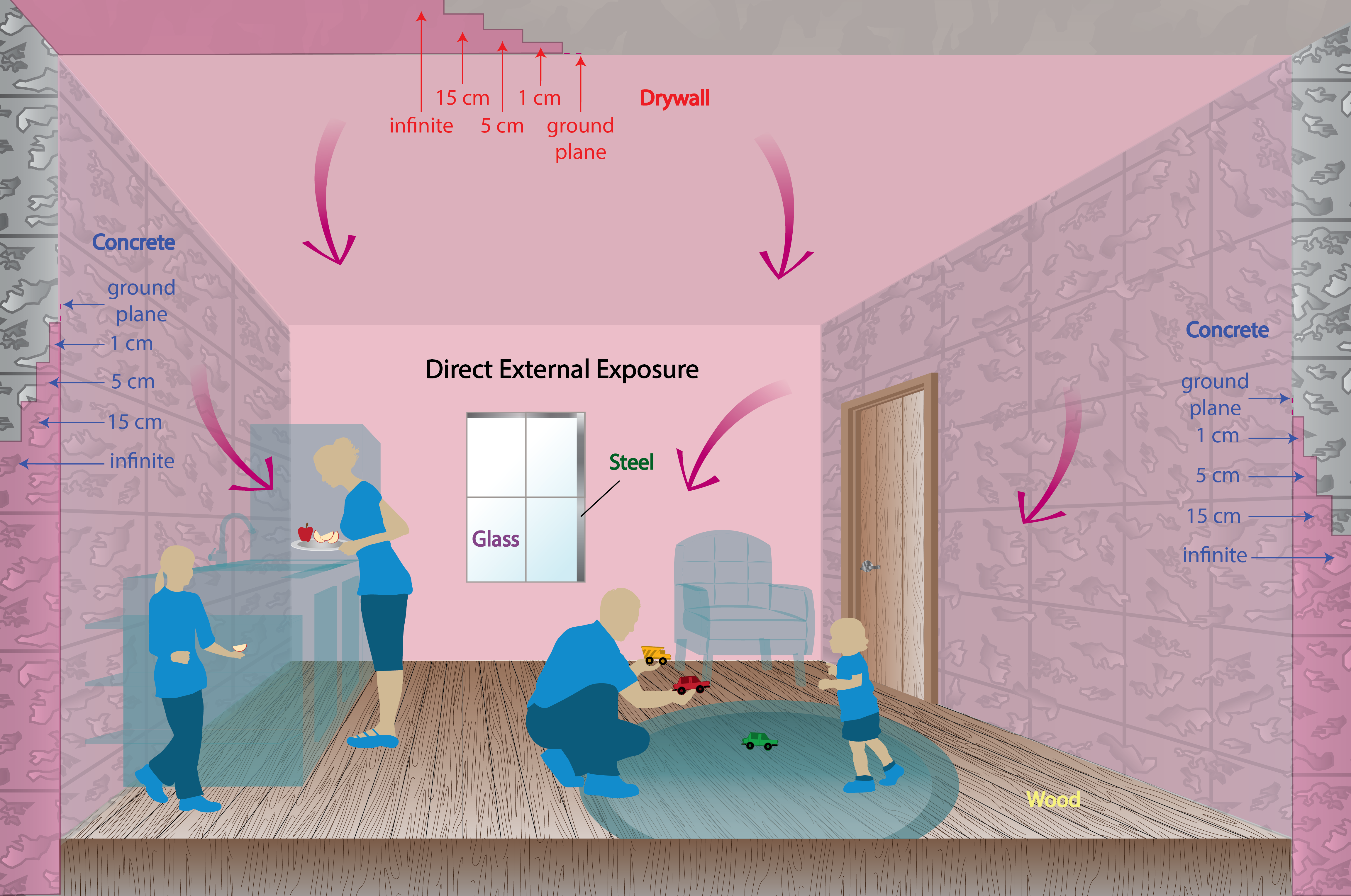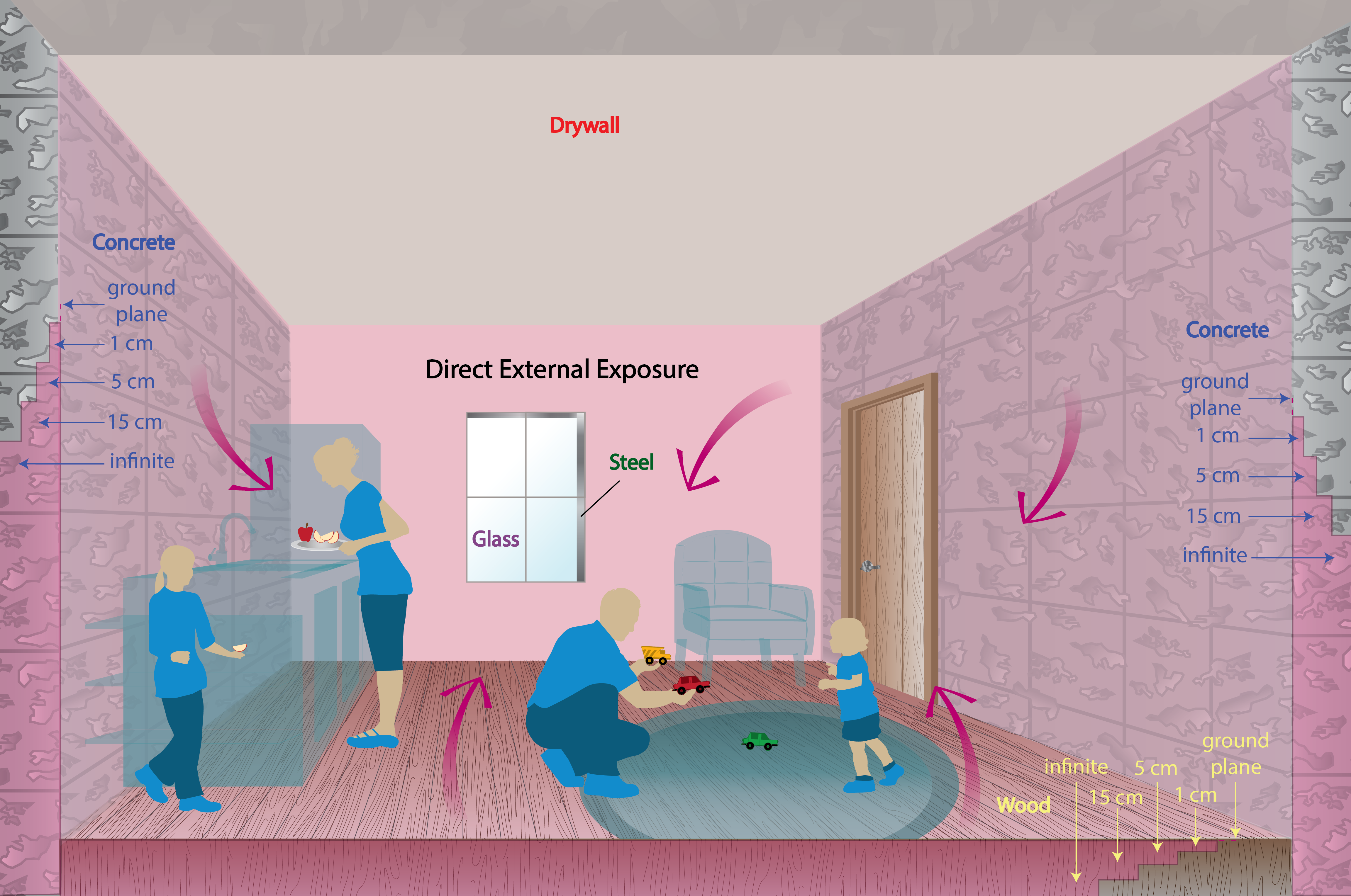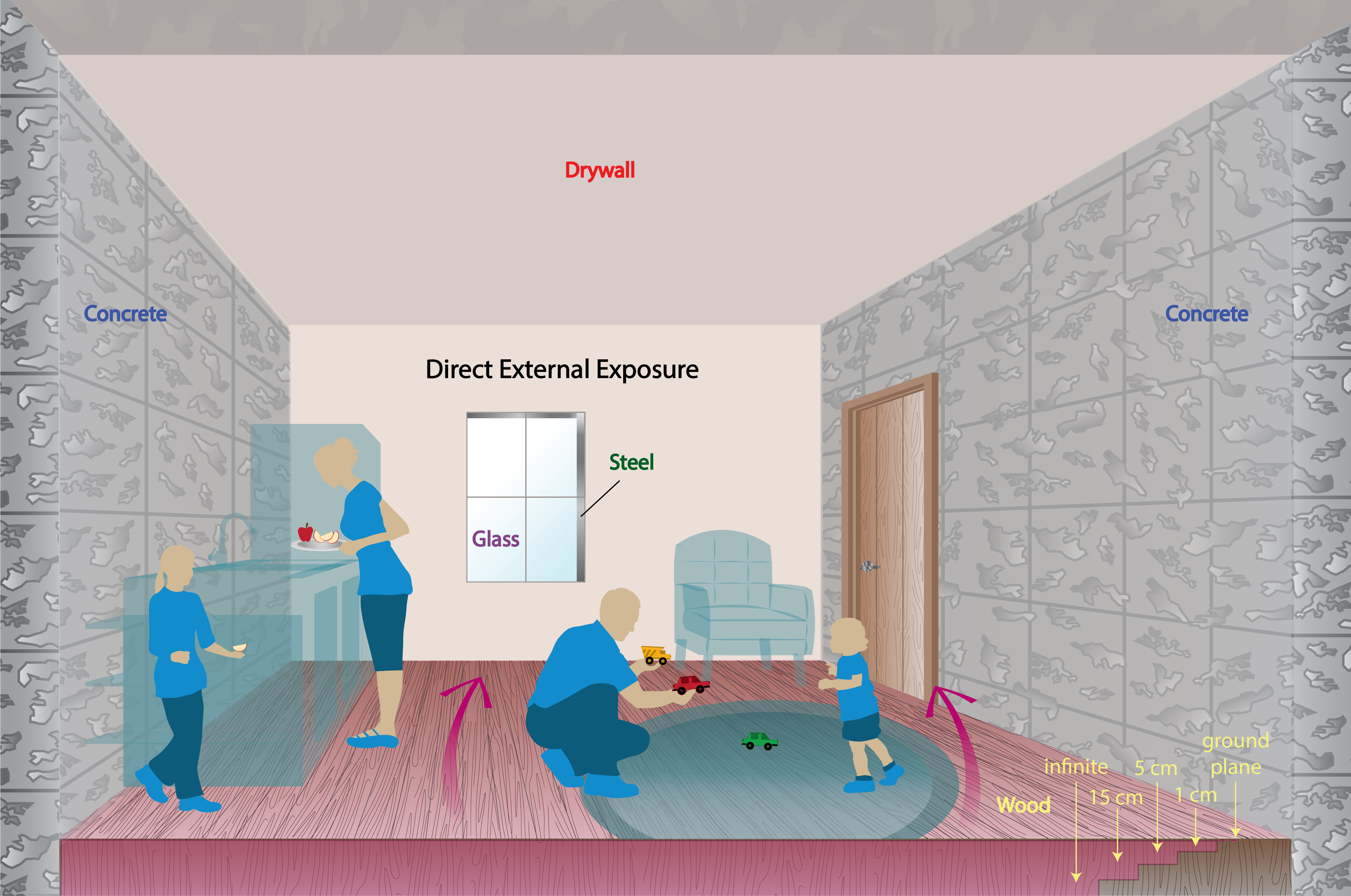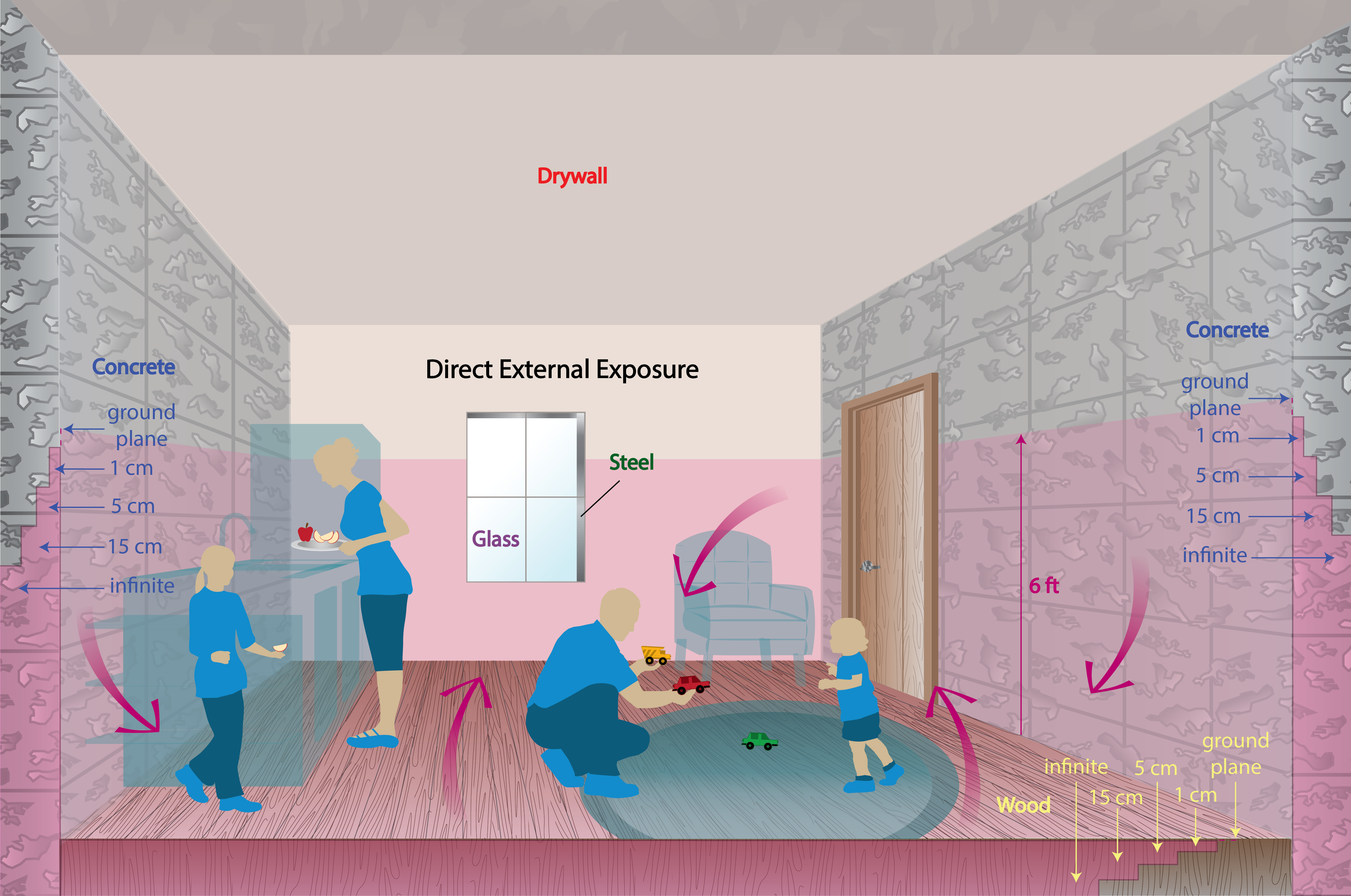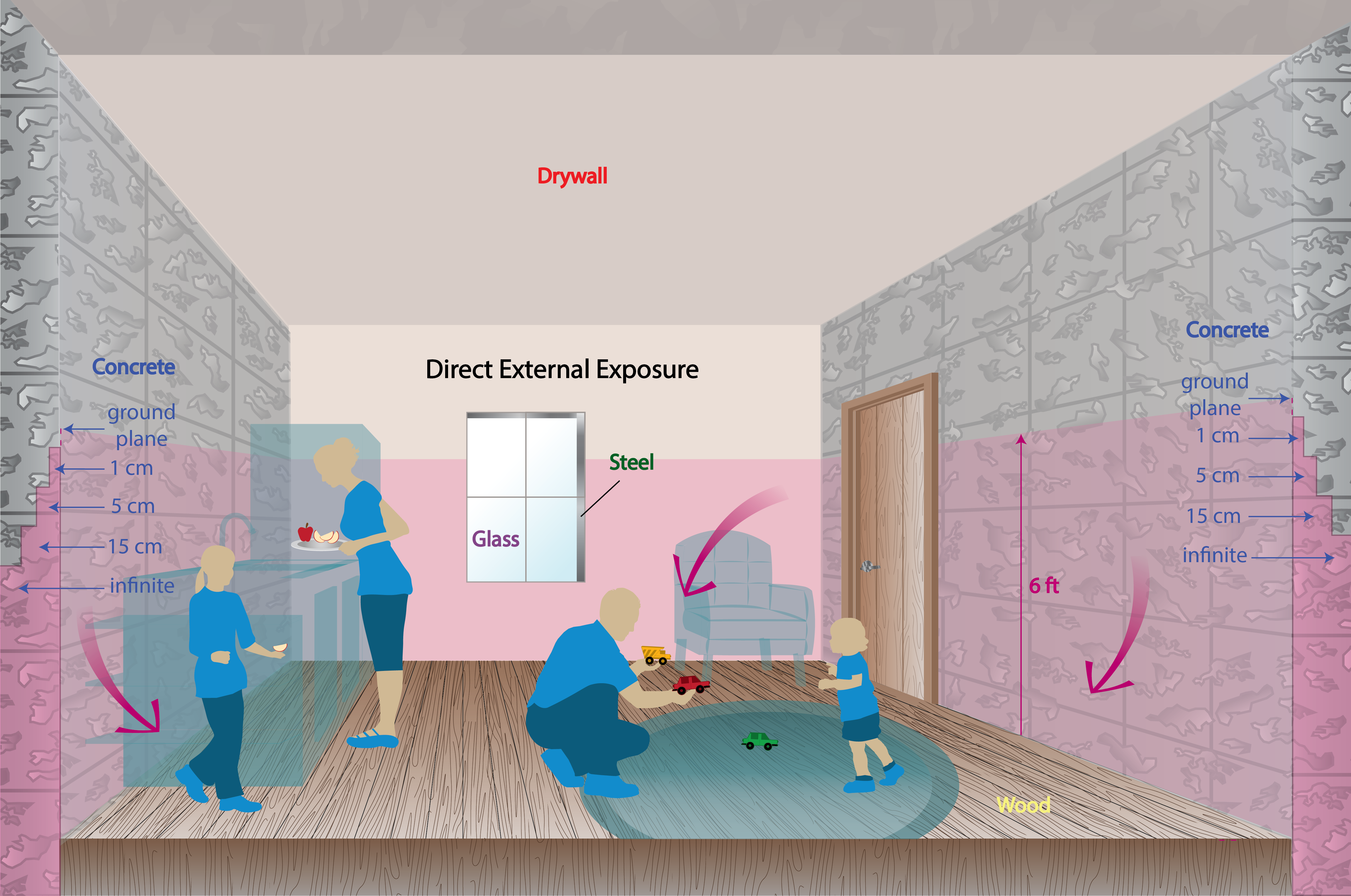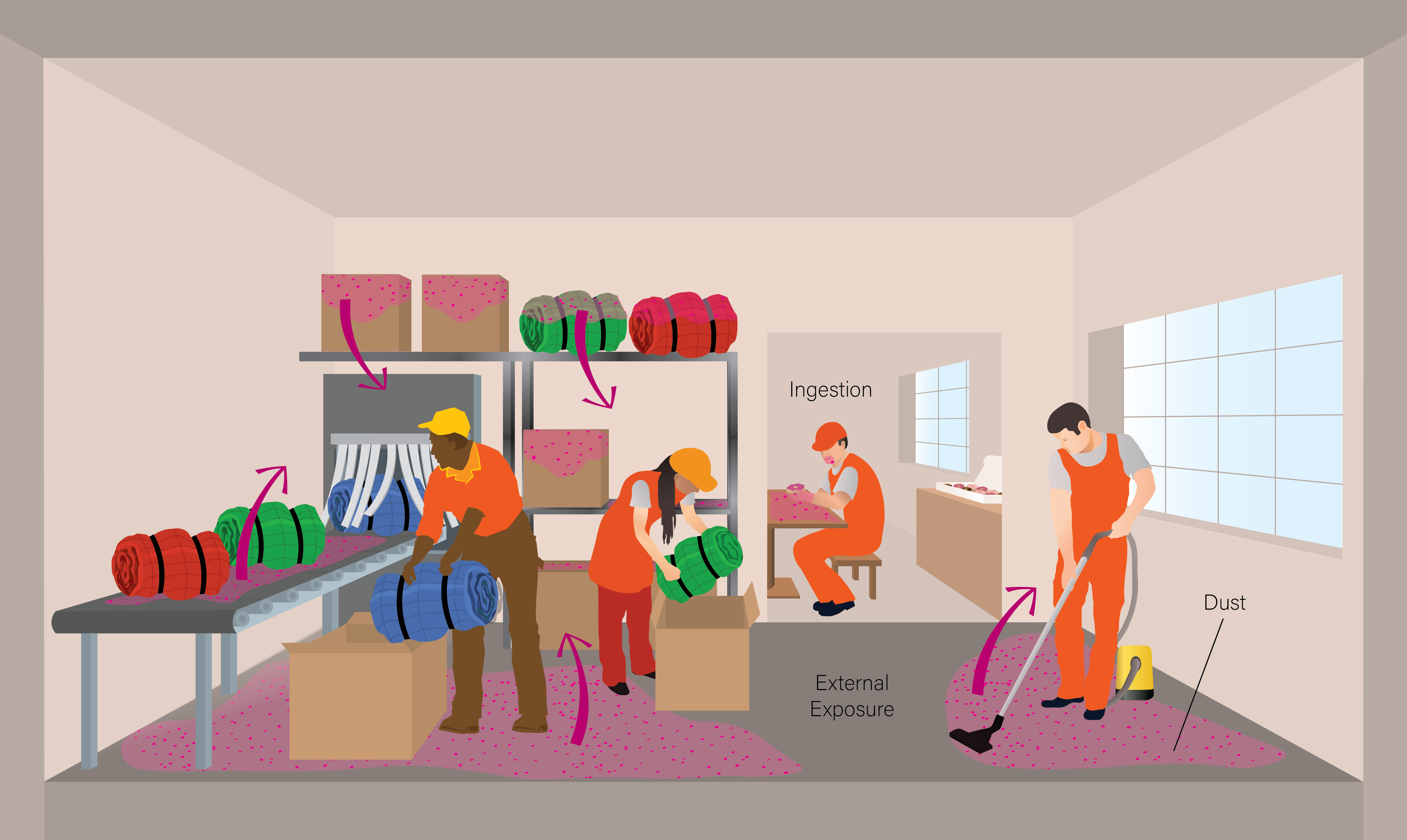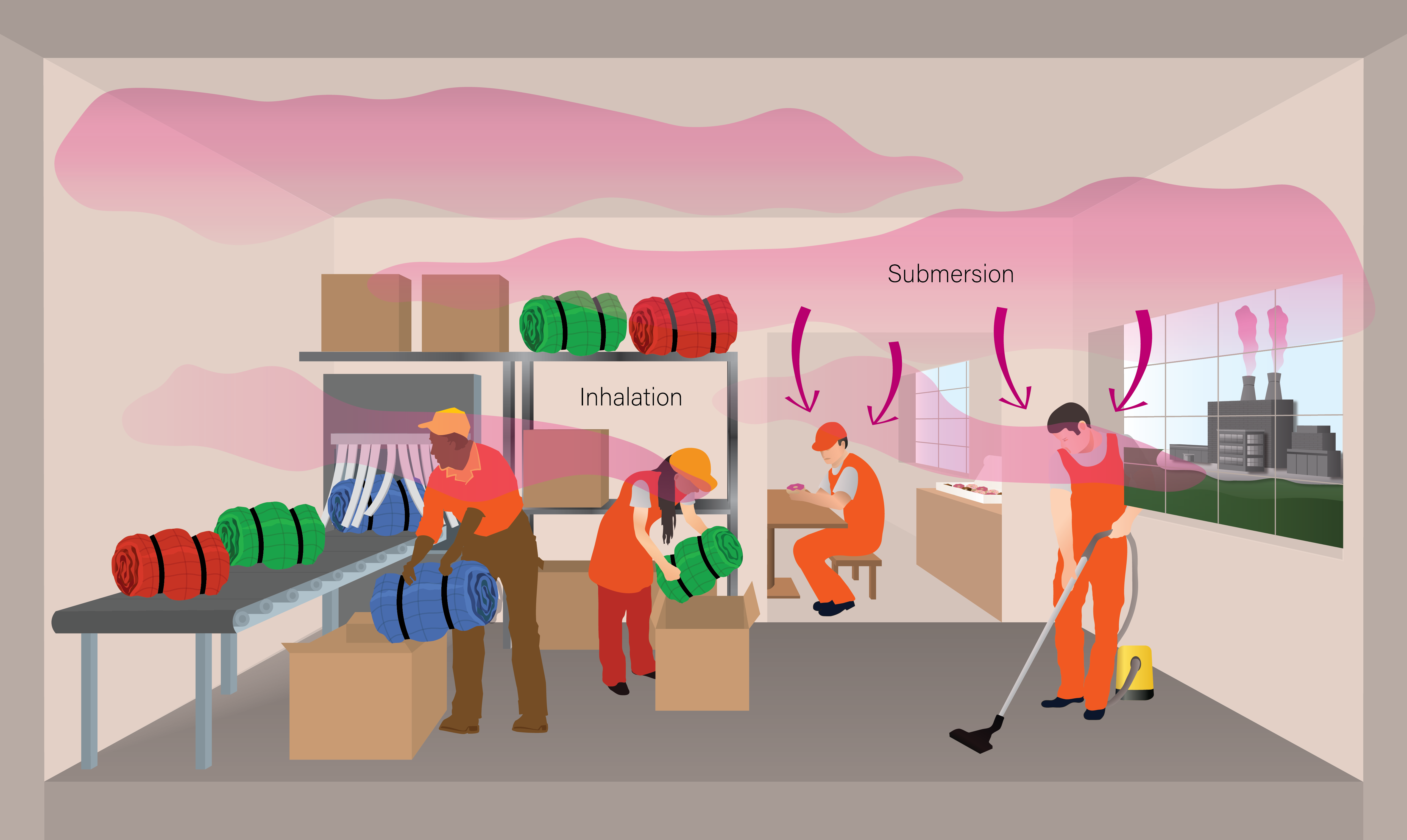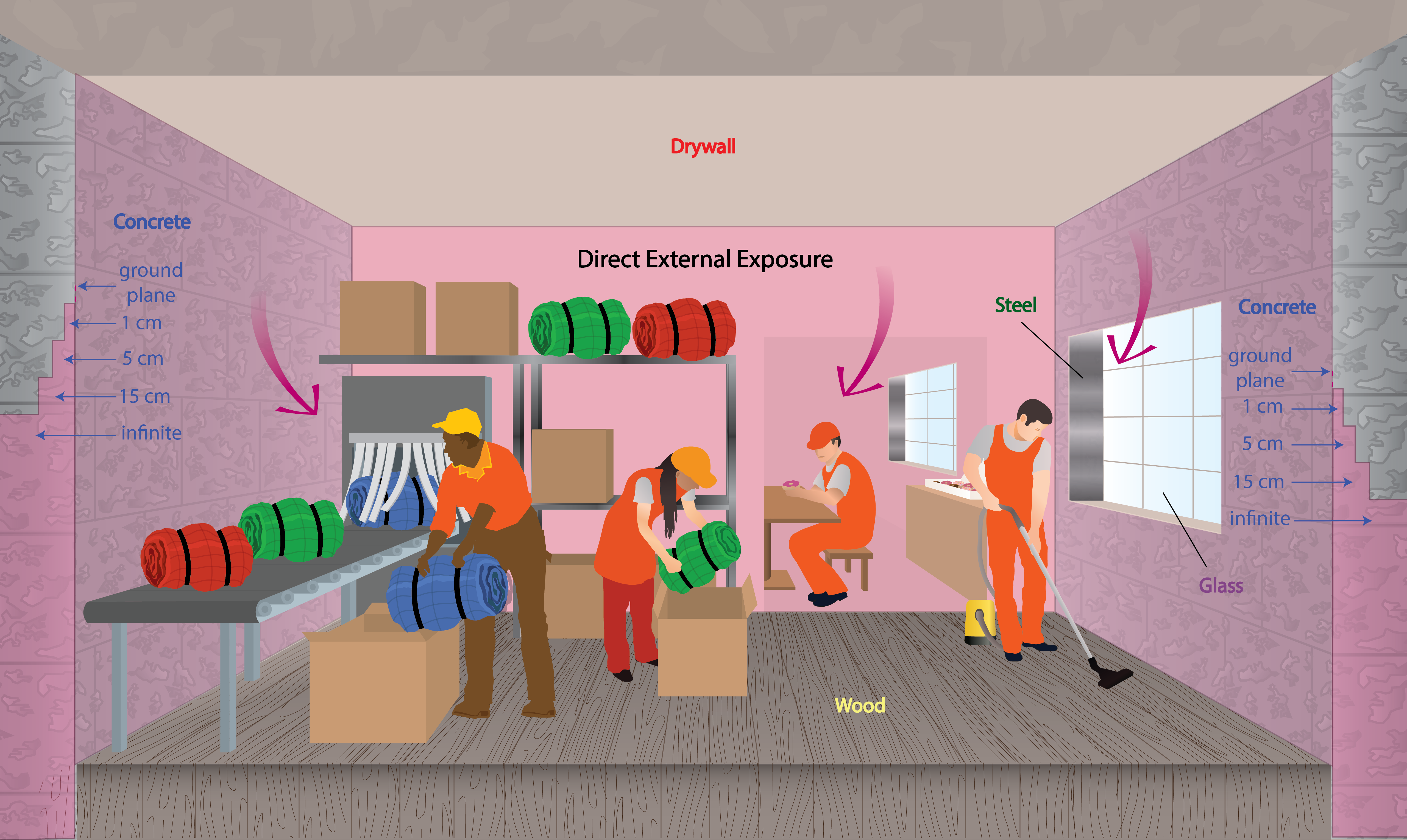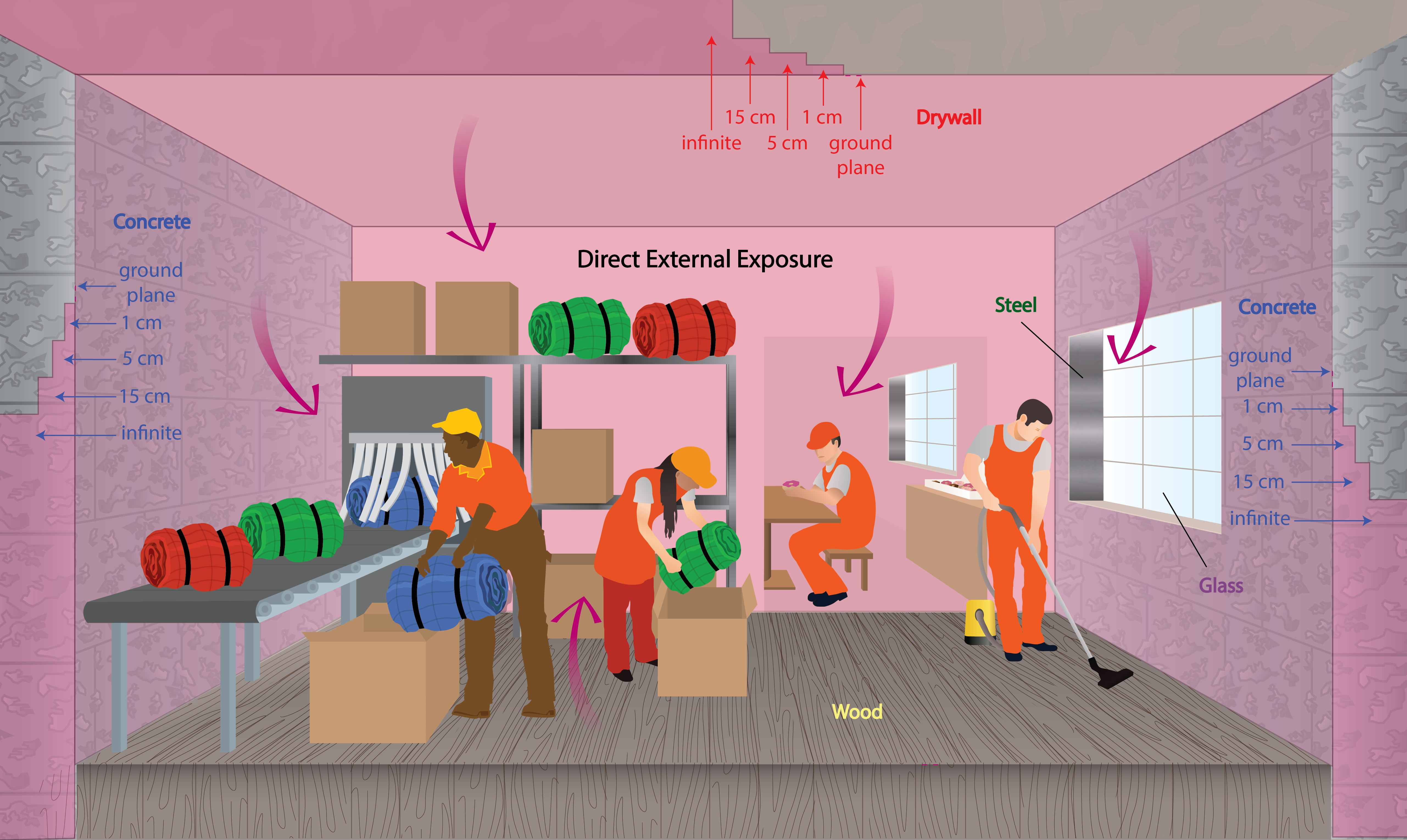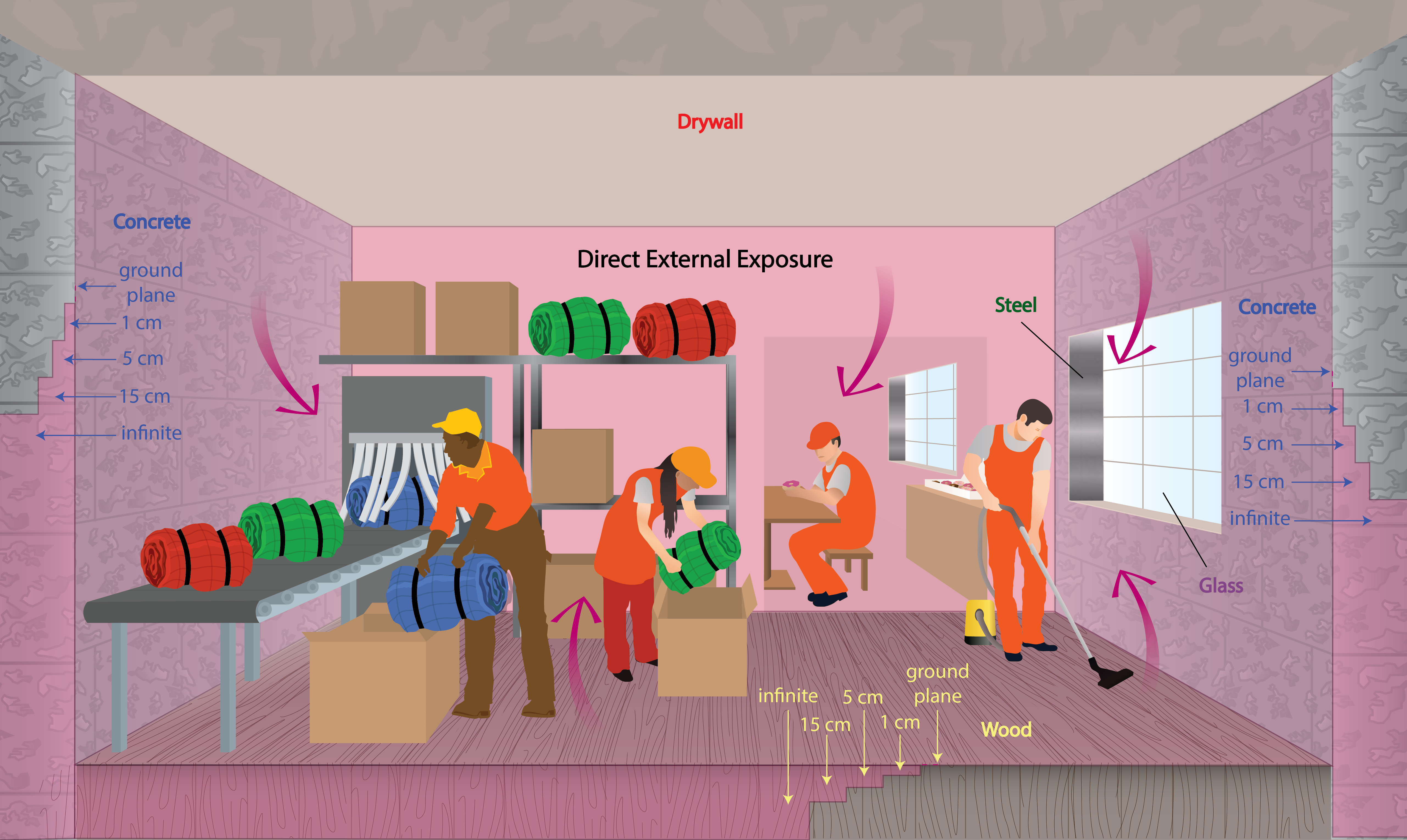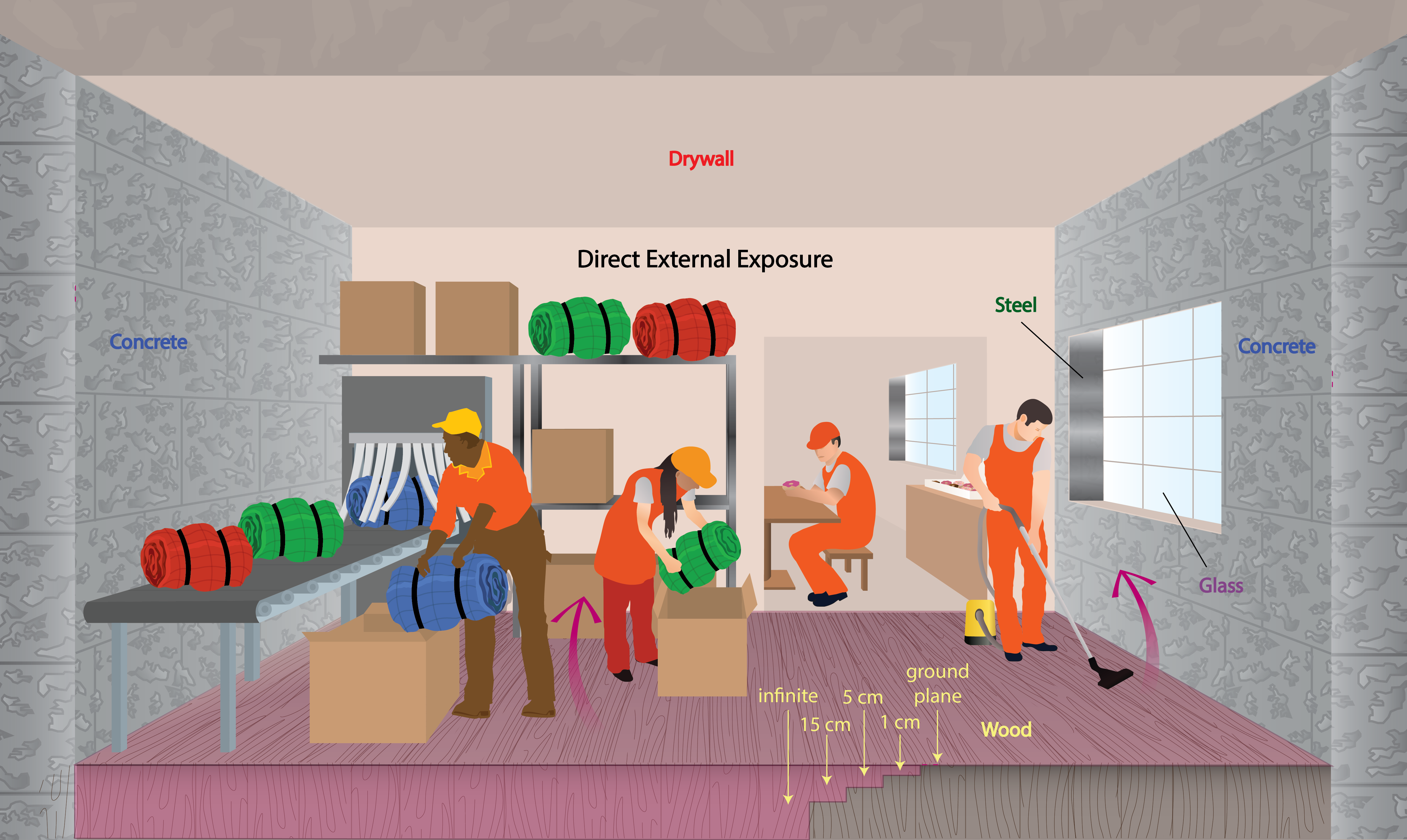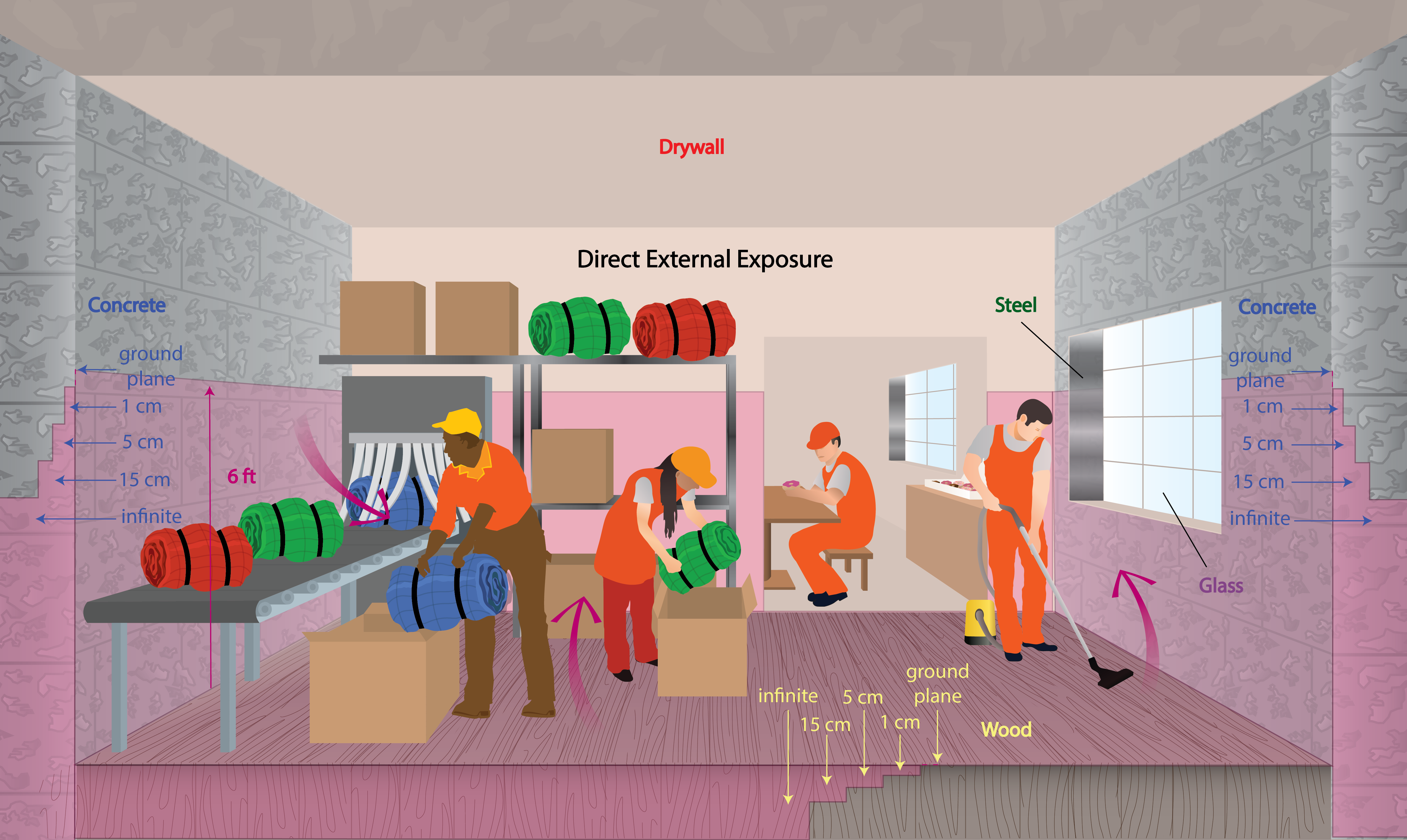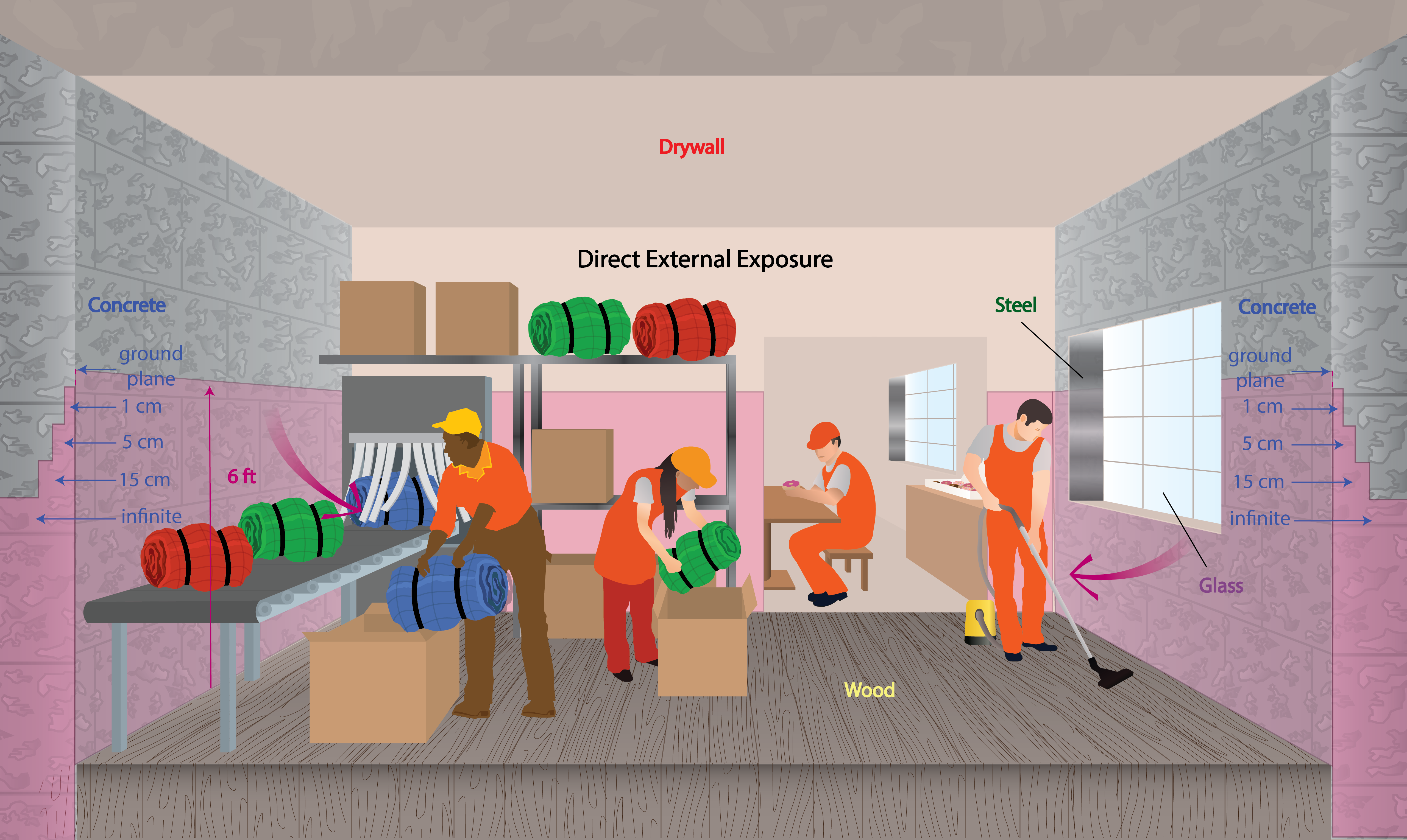page title goes here Risk Assessment
BDCC User's Guide
BDCCs for
Radionuclides
Welcome to the EPA's "Dose Compliance Concentrations for Radionuclides in Buildings at Superfund Sites" (BDCC) user's guide. Here, you will find descriptions, equations, and default exposure parameters used to calculate the dose-based BDCCs. Additional guidance is also provided on sources of parameters and proper BDCC use. It is suggested that users read the BDCC FAQ page before proceeding. The user guide is extensive, so please use the "Open All Sections" and "Close All Sections" links below as needed. Individual sections can be opened and closed by clicking on the section titles. Before proceeding through the user's guide, please read the Disclaimer.
Open All Sections | Close All Sections
Disclaimer
This guidance document sets forth recommended approaches based on EPA's best thinking to date with respect to dose assessment for response actions at CERCLA sites. This document does not establish binding rules. Alternative dose assessment approaches may be more appropriate at specific sites (e.g., where site circumstances do not match the underlying assumptions, conditions, and models of the guidance). The decision to use an alternative approach and a description of any such approach should be placed in the Administrative Record for the site. Accordingly, if comments are received at individual sites questioning the use of the approaches recommended in this guidance, the comments should be considered and an explanation provided for the selected approach.
The policies set out in the Radionuclide ARAR BDCC User Guide provide guidance to EPA staff. It also educates the public and regulated community on how EPA intends the National Oil and Hazardous Substances Pollution Contingency Plan (NCP) be implemented. EPA may change this guidance in the future, as appropriate. This calculator is intended for use by risk assessors, health physicists, and other qualified environmental protection specialists.
It should also be noted that BDCCs do not address human cancer risk, noncancer toxicity, or potential ecological risk. Of the radionuclides generally found at CERCLA sites, only uranium has potentially significant noncancer toxicity. When assessing sites with uranium as a contaminant, it may also be necessary to consider the noncancer toxicity of uranium using other tools, such as EPA's Regional Screening Levels (RSLs) for Chemical Contaminants at Superfund Sites electronic calculator for uranium in soil, water, or air and the WTC for uranium inside buildings. EPA's DCC Calculator should be used to assess radionuclide dose in soil, water, and air and the SDCC Calculator for radionuclide dose for hard outside surfaces. EPA's PRG Calculator should be used to assess radionuclide cancer risk for soil, water, and air, BPRG Calculator for radionuclide cancer risk inside buildings, and the SPRG Calculator for radionuclide cancer for hard outside surfaces. Similarly, some sites with radiological contaminants in sensitive ecological settings may also need to be evaluated for potential ecological risk. EPA's guidance "Ecological Risk Assessment Guidance for Superfund: Process for Designing and Conducting Ecological Risk Assessment" contains an eight step process for using benchmarks for ecological effects in the remedy selection process.
1. Introduction
Generally, these recommended Dose Compliance Concentrations for Radionuclides inside Buildings (BDCCs) are reasonable maximum exposure (RME) risk concentrations derived from standardized equations that combine exposure information and toxicity information in the form of dose conversion factors (DCFs). Recommended BDCCs are presented for residential and indoor worker exposure. Dose conversion factors (DCFs) (U.S. EPA 1988) , more recently called dose coefficients, are used to calculate dose. For the purposes of this guide we retain the DCF abbreviation.
The U.S. Environmental Protection Agency developed the BDCC tool to help standardize the evaluation and cleanup of radioactively contaminated sites where doses are being assessed. This guidance provides a methodology for radiation professionals to calculate dose-based, site-specific, dose compliance concentrations (BDCCs) for radionuclides inside of buildings while complying with a dose-based standard as an ARAR. This guidance supersedes the dose assessment methodology contained in the Risk Assessment Guidance for Superfund Volume I, Human Health Evaluation Manual (Part A) (U.S. EPA 1989).
A number of different radiation standards may be used as Applicable or Relevant and Appropriate Requirements (ARARs) to establish cleanup levels at a site. Cleanup levels may be based on a number of Federal or State ARARs. Federal standards, expressed in terms of dose, that are potential ARARs at CERCLA sites include 40 CFR Part 190, "Environmental Radiation Protection Standards for Nuclear Power Operations", 40 CFR Part 191, "Environmental Radiation Protection Standards for Management and Disposal of Spent Nuclear Fuel, High-Level and Transuranic Radioactive Wastes", or 10 CFR Part 61, "Licensing Requirements for Land Disposal of Radioactive Waste", among others.
One set of radiation standards consists of a combination of whole body and critical organ dose annual limits, generally either: (1) 25 mrem to the whole body, 75 mrem to the thyroid, and 25 mrem to any other critical organ besides the thyroid or (2) 25 mrem/yr to the whole body and 75 mrem/yr to any critical organ (including the thyroid). Another set of standards consists of a single limit (e.g., 10 mrem/yr). The type of dose limit used in the standard would be the same dose methodology used for conducting dose assessment to demonstrate ARAR compliance.
The approach to dose limitation and the methods used to calculate doses have evolved over time. The first two radiation protection standards listed above (the 25/75/25 and 25/75 mrem annual dose limits) are based on the older, critical organ concept of dose limitation. This approach limits dose and long-term effects to a specific target tissue or organ (e.g., the thyroid), the most radiosensitive tissue or organ, or the tissue or organ receiving the highest dose. Under this approach, introduced in 1959 by the International Commission on Radiological Protection (ICRP) in its Publication 2, "Report of Committee II on Permissible Dose for Internal Radiation" (ICRP, 1959), the dose to an organ from internally-deposited radionuclides is calculated separately from the dose due to external exposure, and the whole body is essentially treated as one of the critical organs.
Later, standards were based on the effective dose equivalent concept of dose limitation, introduced in 1977 by the ICRP in its Publication 26, "Recommendations of the International Commission on Radiological Protection" (ICRP, 1977). The effective dose equivalent approach accounts for the differences in the cancer induction rates in organs and tissues subjected to equal doses of radiation and normalizes these doses and effects on a whole body basis. Under this approach, the effective dose equivalent dose is calculated as the weighted sum of the committed dose equivalents (from ingested and inhaled radionuclides) and the dose equivalent (for external exposure from photon-emitting radionuclides) to all organs and tissues. The weighting factors used in these calculations are organ-specific and correspond to the fractional contribution of each organ or tissue to the total risk of fatal cancers when the body is uniformly irradiated. Thus, the summation of all organ and tissue factors is equal to one.
ICRP has since updated the effective dose equivalent concept with the introduction of effective dose quantity in its Publication 60, "1990 recommendations of the International Commission on Radiological Protection" (ICRP, 1991). While similar to the effective dose equivalent approach, the effective dose quantity incorporates updated scientific information in the dose conversion factors. Effective dose quantity incorporates a greater number of organs, updated information on organ-specific risk, and age-specific dose coefficients for internal exposure that incorporate new physiologically-based biokinetic models.
ICRP Publication 107 (ICRP 2008) provides an electronic database of the physical data for calculations of radionuclide-specific protection and operational quantities. This database supersedes the data of ICRP 38 and will be used in future ICRP publications of dose coefficients for the intake of or exposure to radionuclides in the workplace and the environment.
The purpose of this document is to guide EPA personnel in calculating release criteria based on regulations promulgated under various methods of dose calculation. This guidance will relate these dose limits to a single measure, cleanup concentration. This guidance will assist RPMs in making decisions at these sites.
Note: use of this calculator to develop dose compliance concentrations for some dose-based ARARs does not affect the CERCLA requirement to comply with all other Federal and State ARARs at a site (e.g., 40 CFR 141.66, 40 CFR 192.12). ARARs are determined site-specifically. For a list of "Likely Federal Radiation Applicable or Relevant and Appropriate (ARARs)", see Attachment A of EPA's guidance "Establishment of Cleanup Levels for CERCLA sites with Radioactive Contamination." For additional guidance documents on compliance with ARARs at radioactively contaminated sites, go to the following webpage: https://www.epa.gov/superfund/radiation-superfund-sites
This website uses DCFs provided by the Center for Radiation Protection Knowledge. The main report is Calculations of Slope Factors and Dose Coefficients, and the tables of DCFs are in a separate appendix. The DCFs are combined with “standard” exposure factors to estimate contaminant concentrations inside buildings that attain compliance with a dose-based ARAR. Exceeding a BDCC usually suggests that further evaluation of the potential dose is appropriate. The BDCC concentrations presented on this website can be used to screen pollutants in environmental media, trigger further investigation, and provide initial cleanup goals, if applicable. BDCCs should be applied in accordance with guidance from EPA Regions.
In addition to this guidance, for relevant training, see the internet-based course "Radiation Risk Assessment: Updates and Tools".
2. Understanding the BDCC Website
This website offers the ability to quickly look up or calculate BDCCs. Within the BDCCs are many complex models that require a greater understanding when using the calculator in site-specific mode. The sections that follow expand upon these models and should be consulted before generating site-specific BDCCs.
2.1 General Considerations
BDCCs are radionuclide concentrations that correspond to annual levels of dose (e.g., mrem) inside a building. The BDCCs, regardless of land use, are based on annual dose and differ from BPRGs which are based on 26 years for resident and 25 years for indoor workers. Dose Coefficients (DCFs) represent the dose equivalent per unit intake (i.e., ingestion or inhalation) or external exposure for a given radionuclide. In dose assessments, these DCFs are used in calculations with radionuclide concentrations and exposure assumptions to estimate dose from exposure to radioactive contamination. The calculations may be rearranged to generate BDCCs for a specified level of dose. DCFs may be specified for specific body organs or tissues of interest or as a weighted sum of individual organ dose, termed the effective dose equivalent. These DCFs may be multiplied by the total activity of each radionuclide inhaled or ingested per year or the external exposure concentration to which a receptor may be exposed to estimate the dose to the receptor. Dose Coefficients used are provided by the Center for Radiation Protection Knowledge. The main report is Calculations of Slope Factors and Dose Coefficients and the tables of DCFs are in a separate appendix.
Inhalation dose coefficients are tabulated separately for each of the three lung absorption types considered in the lung model currently recommended by the International Commission on Radiological Protection (ICRP) and, where appropriate, for inhalation of radionuclides in vapor or gaseous forms.
The designations "F", "M", and "S" presented in the Radionuclide Table under the heading "ICRP Lung Type" refer to the lung absorption type for inhaled particulate radionuclides, expressed as fast (F), medium (M), or slow (S), as used in the current ICRP model of the respiratory tract. The inhalation slope factor value tabulated in the Radionuclide Table for each radionuclide has been selected based on the following guidelines: (1) For those elements where Table 4.1 of Federal Guidance Report No. 13 (and Table 2 of ICRP Publication 72) specifies a recommended default lung absorption type for particulates, the inhalation slope factor for that type is tabulated in the Radionuclide Table for each radioisotope of that element; (2) For those elements where no specific lung absorption type is recommended and multiple types are indicated as plausible choices, the inhalation slope factor reported in the Radionuclide Table for each radioisotope of that element is the maximum of the values for each of the plausible lung absorption types; and (3) If Federal Guidance Report No. 13 specifies risk coefficients for multiple chemical forms of certain elements (tritium, carbon, sulfur, iodine, and mercury), the inhalation slope factor value for the form estimated to pose the maximum risk is reported in the Radionuclide Table, in most cases.
Inhaled particulates are assumed to have an activity median aerodynamic diameter (AMAD) of 1 um, as recommended by the ICRP for consideration of environmental exposures in the absence of specific physical characteristics of the aerosol. Where appropriate, radionuclides may be present in gas or vapor form and are designated by "G" and "V", respectively; such radionuclides include tritium, carbon, sulfur, nickel, ruthenium, iodine, tellurium, and mercury.
The most likely exposure scenarios and exposure assumptions are included in the equations on this website: Resident and Indoor Worker.
The BDCCs are generated with standard exposure route equations using EPA DCFs and parameters. Exposures to other media can be addressed by other calculators. For exposure to contaminated materials outside a building, use the SDCC (Dose Compliance Concentrations for Radionuclides on Outdoor Surfaces at Superfund Sites), respectively. A DCC calculator receptor represents the reasonably maximum exposed (RME) individual, as does a BDCC receptor. Since the DCC RME is often outside and the BDCC RME is always indoors, an individual receiving both indoor and outdoor exposures at a site should be protected when both tools are used.
For the calculation of dose conversion factors, a standard soil density of 1.6 g/cm3 has been used.
2.2 BDCC Output Options
The calculator offers four options for calculating BDCCs. Previous versions of this calculator employed dose coefficients that included progeny ingrowth for 100 years, designated "+D." The +D dose coefficients are no longer included in the pick list. See section 2.8.2 to learn more. This section describes the potential applications of the four choices and recommends a default DCC calculation.
2.2.1 BDCC Output Option #1: Assumes period of peak dose (with decay and progeny ingrowth)(Peak BDCC)
This is the preferred BDCC calculation option and is marked as the default selection in the calculator. The Peak BDCC is calculated for the time period when the parent and progeny activities present the most dose. The underlying assumption of the Peak BDCC option is that a pure isotope was released and progeny begin ingrowth and decay. This BDCC is protective, as future progeny may contribute more dose than the parent. When a single isotope is selected, the calculator identifies all the progeny in the chain. The BDCCs for each progeny are combined with the parent based on their fractional contribution (FC). The FC is determined by branching fractions, where a progeny may decay into more than one isotope. Section 2.2.2 presents details on calculating the FC. Unlike previous BDCC output options that included progeny contribution (i.e., +D BDCCs as discussed in section 2.8.2.), the Peak BDCC models each progeny independently of the parent for half-life. The BDCC provided in the output is the inverse sum of the reciprocal BDCCs of the parent and all the progeny present at the period of peak dose. All BDCC equation images are presented without a radioactive decay term; however, decay and ingrowth is included in this BDCC option.
When the Peak BDCC output option is selected, the BDCC Calculator shows the individual progeny contributions for the total BDCC. At the top of the output page, the results are separated into tabs by media. In the Peak BDCC output, the individual exposure routes are presented separately. This is done to help determine which exposure routes are dose drivers that may help to focus site-specific remedial efforts. The period of peak dose may differ for some exposure routes (e.g., external and dust ingestion) as well as the total Peak BDCC. Forward dose calculations are also available for this output option.
The Peak BDCC output option can be run for an infinite time period or a user-defined time period.
2.2.1.1 Infinite Time
The default setting for the Peak BDCC option is to search for the period of peak dose out to infinity. To accomplish this, the Peak BDCC uses a Bateman solver to determine the parent and progeny activities out to a trillion years. This isotopic activity curve is then converted to dose, and another routine selects the time period with the most dose from parent and progeny and determines the parent activity (BDCC) that would represent the target dose. Users should note that for long-lived isotopes that have a peak dose that begins in the future, progeny are likely already ingrown, and the secular equilibrium (SE) BDCCs may be appropriate. This ORNL Technical Memorandum offers explanation of the derivation of the Peak BDCCs.
2.2.1.2 User-defined Time Period
The user may also select a defined time period to search for the period of peak dose. This option operates just like the infinite time option but stops searching for the period of peak dose at a user-defined time in the future. Predefined time points of 10,000, 1,000, and 100 years are offered as well as the option for the user to enter a specific time period between 70 and one trillion years. These options are only offered for use in certain situations where a regulatory agency is concerned with dose at certain time points in the future. If a peak hasn't been resolved in the entered time period, as is the case when progeny are still ingrowing, the dose interval will be calculated for the last exposure duration span. For instance, if the time period of 100 years is selected for default resident dust for U-238 (ED of 1 year), year 100 will be selected by default, because U-238 peak dose isn't until year 3,981,072.
User-defined time periods should only be considered when a purified radionuclide was recently disposed or released. These time periods should not be considered when a radionuclide has been present long enough for progeny to ingrow (e.g., uranium, thorium, and radium as ore material). The default selection of infinity is the preferred option for use on Superfund sites being remediated for unrestricted future land uses.
Click Here for a Tutorial on Understanding Peak BDCC Graphs
The following images provide instructions for exploring and understanding the peak dose graphs.
2.2.2 BDCC Output Option #2: Assumes Secular Equilibrium Throughout the Chain (no decay - parent and progeny in constant equilibrium)
This was the default DCC calculation option prior to the release of the Peak BDCC. When a single isotope is selected, the calculator identifies all the progeny in the chain. The BDCCs for each progeny are combined with the parent on a fractional basis. The fractional basis is determined by branching fractions where a progeny may decay into more than one isotope. The resulting BDCC is now based on secular equilibrium of the full chain. For straight chain decay, all the progeny would be at the same activity of the parent, and the BDCC provided in the output would be the inverse sum of the reciprocal BDCCs of the parent and all the progeny. Currently, all the soil BDCC equation images are presented with a radioactive decay term to account for half-lives shorter than the exposure duration. Decay is not included in this BDCC option, as the assumption of secular equilibrium is that the parent is continually being renewed.
When the secular equilibrium BDCC output option is selected, the BDCC Calculator now gives the option to show the individual progeny contributions for the BDCC (and dose) output. When the option to display progeny contribution is selected, the BDCC Calculator output gives the secular equilibrium BDCC and the individual progeny BDCCs in separate tables.
A total BDCC is calculated using the following formula.
The EPA Decay Chain tool provides the branching fractions for each radionuclide's decay chain, based on the ICRP 107 data. The branching fractions presented, for non-converging chains, are used directly in the BPRG equation above for the FC (fractional contribution) term. Convergence in a chain is when there are multiple decay pathways to a particular isotope or when multiple isotopes can decay to a particular isotope. When a chain converges, as is the case with the Ra-226 chain, the effect of multiple branches needs to be taken into account. Consider the branching fractions in the Ra-226 decay chain in the table below.
Nuclide Half-life Mode Mass Branching
FractionProgeny Branching
FractionProgeny Ra-226 1600 years A 226.025409 1.00e+0 Rn-222 Rn-222 3.8235 days A 222.017577 1.00e+0 Po-218 Po-218 3.10 minutes B-,A 218.008973 1.00e+0 Pb-214 2.00e-4 At-218 Pb-214 26.8 minutes B- 213.999805 1.00e+0 Bi-214 At-218 1.5 seconds A,B- 218.008694 9.99e-1 Bi-214 1.00e-3 Rn-218 Bi-214 19.9 minutes B-,A 213.998711 1.00e+0 Po-214 2.10e-4 Tl-210 Rn-218 3.50e-2 seconds A 218.005601 1.00e+0 Po-214 Po-214 1.64e-4 seconds A 213.995201 1.00e+0 Pb-210 Tl-210 1.3 minutes B- 209.990073 1.00e+0 Pb-210 Pb-210 22.2 years B-,A 209.984188 1.00e+0 Bi-210 1.90e-8 Hg-206 Bi-210 5.01 days B-,A 209.984120 1.00e+0 Po-210 1.32e-6 Tl-206 Hg-206 8.15 minutes B- 205.977514 1.00e+0 Tl-206 Po-210 138.38 days A 209.982873 1.00e+0 Stable Pb-206 Tl-206 4.2 minutes B- 205.976110 1.00e+0 Stable Pb-206 For example, the branching fraction presented in the above table for At-218 decaying to Rn-218 is 0.1% (0.001 or 1.0E-03); however, this isn't the complete picture, because At-218 appears in the chain as only 0.02% of Po-218 decay. To determine the true fractional contribution of Rn-218 to the whole chain, multiply the two branching fraction ratios together as follows: 2.0E-04 x 1.0E-03 = 2.0E-07. Technically, to calculate the fractional contribution of each isotope in a chain, each unique pathway to that isotope should have its branching fractions multiplied together and each result summed. The tables below present this process for At-218, Rn-218, Tl-210, Hg-206, and Tl-206, respectively. The FCs for the other progeny are all 1.0.
Determination of Fractional Contribution (FC) from Converging Branching Fractions in the Ra-226 Decay Chain. At-218 FC Ra-226
to
Rn-222Rn-222
to
Po-218Po-218
to
At-218Fraction 1 1 2.00E-04 2.00E-04 Total FC 2.00E-04 Rn-218 FC Ra-226
to
Rn-222Rn-222
to
Po-218Po-218
to
At-218At-218
to
Rn-218Fraction 1 1 2.00E-04 1.00E-03 2.00E-07 Total FC 2.00E-07 Tl-210 FC Ra-226
to
Rn-222Rn-222
to
Po-218Po-218
to
At-218At-218
to
Bi-214Bi-214
to
Tl-210Fraction 1 1 2.00E-04 1 2.10E-04 4.20E-08 Ra-226
to
Rn-222Rn-222
to
Po-218Po-218
to
Pb-214Pb-214
to
Bi-214Bi-214
to
Tl-2101 1 1 1 2.10E-04 2.10E-04 Total FC 2.10E-04 Hg-206 FC Ra-226
to
Rn-222Rn-222
to
Po-218Po-218
to
At-218At-218
to
Rn-218Rn-218
to
Po-214Po-214
to
Pb-210Pb-210
to
Hg-206Fraction 1 1 2.00E-04 1.00E-03 1 1 1.90E-08 3.8E-15 Ra-226
to
Rn-222Rn-222
to
Po-218Po-218
to
At-218At-218
to
Bi-214Bi-214
to
Po-214Po-214
to
Pb-210Pb-210
to
Hg-2061 1 2.00E-04 1 1 1 1.90E-08 3.8E-12 Ra-226
to
Rn-222Rn-222
to
Po-218Po-218
to
At-218At-218
to
Bi-214Bi-214
to
Tl-210Tl-210
to
Pb-210Pb-210
to
Hg-2061 1 2.00E-04 1 1 1 1.90E-08 3.8E-12 Ra-226
to
Rn-222Rn-222
to
Po-218Po-218
to
Pb-214Pb-214
to
Bi-214Bi-214
to
Po-214Po-214
to
Pb-210Pb-210
to
Hg-2061 1 1 1 1 1 1.90E-08 1.90E-08 Ra-226
to
Rn-222Rn-222
to
Po-218Po-218
to
Pb-214Pb-214
to
Bi-214Bi-214
to
Tl-210Tl-210
to
Pb-210Pb-210
to
Hg-2061 1 1 1 2.10E-04 1 1.90E-08 3.99E-12 Total FC 1.90E-08 Tl-206 FC Ra-226
to
Rn-222Rn-222
to
Po-218Po-218
to
At-218At-218
to
Rn-218Rn-218
to
Po-214Po-214
to
Pb-210Pb-210
to
Bi-210Bi-210
to
Tl-206Fraction 1 1 2.00E-04 1.00E-03 1 1 1.00E+00 1.32E-06 2.64E-13 Ra-226
to
Rn-222Rn-222
to
Po-218Po-218
to
At-218At-218
to
Rn-218Rn-218
to
Po-214Po-214
to
Pb-210Pb-210
to
Hg-206Hg-206
to
Tl-2061 1 2.00E-04 1.00E-03 1 1 1.90E-08 1.00E+00 3.80E-15 Ra-226
to
Rn-222Rn-222
to
Po-218Po-218
to
At-218At-218
to
Bi-214Bi-214
to
Po-214Po-214
to
Pb-210Pb-210
to
Bi-210Bi-210
to
Tl-2061 1 2.00E-04 1 1 1 1.00E+00 1.32E-06 2.64E-10 Ra-226
to
Rn-222Rn-222
to
Po-218Po-218
to
At-218At-218
to
Bi-214Bi-214
to
Po-214Po-214
to
Pb-210Pb-210
to
Hg-206Hg-206
to
Tl-2061 1 2.00E-04 1 1 1 1.90E-08 1.00E+00 3.80E-12 Ra-226
to
Rn-222Rn-222
to
Po-218Po-218
to
At-218At-218
to
Bi-214Bi-214
to
Tl-210Tl-210
to
Pb-210Pb-210
to
Bi-210Bi-210
to
Tl-2061 1 2.00E-04 1 2.10E-04 1 1.00E+00 1.32E-06 5.54E-14 Ra-226
to
Rn-222Rn-222
to
Po-218Po-218
to
At-218At-218
to
Bi-214Bi-214
to
Tl-210Tl-210
to
Pb-210Pb-210
to
Hg-206Hg-206
to
Tl-2061 1 2.00E-04 1 2.10E-04 1 1.90E-08 1.00E+00 7.98E-16 Ra-226
to
Rn-222Rn-222
to
Po-218Po-218
to
Pb-214Pb-214
to
Bi-214Bi-214
to
Po-214Po-214
to
Pb-210Pb-210
to
Bi-210Bi-210
to
Tl-2061 1 1 1 1 1 1.00E+00 1.32E-06 1.32E-06 Ra-226
to
Rn-222Rn-222
to
Po-218Po-218
to
Pb-214Pb-214
to
Bi-214Bi-214
to
Po-214Po-214
to
Pb-210Pb-210
to
Hg-206Hg-206
to
Tl-2061 1 1 1 1 1 1.90E-08 1.00E+00 1.90E-08 Ra-226
to
Rn-222Rn-222
to
Po-218Po-218
to
Pb-214Pb-214
to
Bi-214Bi-214
to
Tl-210Tl-210
to
Pb-210Pb-210
to
Bi-210Bi-210
to
Tl-2061 1 1 1 2.10E-04 1 1.00E+00 1.32E-06 2.77E-10 Ra-226
to
Rn-222Rn-222
to
Po-218Po-218
to
Pb-214Pb-214
to
Bi-214Bi-214
to
Tl-210Tl-210
to
Pb-210Pb-210
to
Hg-206Hg-206
to
Tl-2061 1 1 1 2.10E-04 1 1.90E-08 1.00E+00 3.99E-12 Total FC 1.34E-06 2.2.3 BDCC Output Option #3: Does Not Assume Secular Equilibrium, Provides Results for Progeny Throughout Chain (with decay where appropriate)
This option displays the BDCCs calculated with half-life decay as identified in the BDCC equation images. In addition to the selected isotope, all the individual progeny BDCCs are displayed. Each BDCC is determined with each isotope's respective half-life and not that of its parent isotope. This option does not assume secular equilibrium and presents all the individual progeny BDCCs, so that the risk assessor can identify any isotopes that will be present and those that have no data. Users can alter progeny half-life to match the parent isotope or other progeny or to account for ingrowth and decay over a chain.
2.2.4 BDCC Output Option #4: Does Not Assume Secular Equilibrium, Selected Isotopes Only (with decay where appropriate)
This option displays BDCCs for only the selected isotopes with half-life decay as identified in the BDCC equation images. In this output, secular equilibrium is not assumed, progeny BDCCs are not displayed, and progeny contribution is not combined into the BDCC for the selected isotope. This option is useful when contamination is from one radionuclide with a very long half-life, where secular equilibrium would be too conservative.
2.2.5 Comparison of Peak BDCC to the other 3 BDCC Output Options
The Peak BDCC output option returns results that are similar to one of the three other output options, depending upon the selected isotopes. For example, some transuranic isotopes (TRUs), such as Pu-238, Pu-239, Pu-240, and Am-241, have relatively short half lives in comparison to subsequent progeny. In such cases, equilibrium is not achieved. The activity of the relatively long-lived progeny grows in slowly, in some cases taking thousands of years to reach a significant fraction of the total activity. Furthermore, the activity of the progeny only reaches a small fraction of the parent's initial activity. For example, U-234 reaches a maximum activity of about 0.04 percent of the initial Pu-238 activity at approximately 1000 years. As such, the BDCC for the parent only option is very similar to that of the Peak BDCC option.
Conversely, secular equilibrium (SE) only occurs when the half-life of the progeny is much shorter than the half-life of the parent. When the progeny has a longer half-life than the parent, equilibrium does not exist. The assumption of SE in these cases significantly overestimates the activity of the progeny, resulting in a much lower BDCC.
The following table presents a comparison of the default indoor worker dust BDCC options for Pu-238, Pu-239, Pu-240, and Am-241 and their long-lived progeny U-234, U-235, U-238, and Np-237, respectively. This table shows that each parent has a half-life about four orders of magnitude shorter than its progeny. As expected, of the three BDCC options presented, the SE BDCC is always the most protective (smallest). For the TRU isotopes, the peak and the parent only BDCCs are shown to be essentially identical, and for the long-lived progeny, the SE and Peak BDCC are more closely related. Also of interest is that the SE BDCCs for the TRU isotopes and their long-lived progeny are very similar but slightly more protective than the TRU isotope BDCCs. This is expected, as the dose contribution to the parent BDCC is only different by one isotope in a long chain.
Isotope Half-life (years) Parent only BDCC (pCi/cm2) SE BDCC (pCi/cm2) Peak BDCC (pCi/cm2) Transuranics With Relative Short Half-lives Compared to Progeny Am-241 4.32E+02 6.55E-02 1.33E-02 6.55E-02 Pu-238 8.77E+01 5.88E-02 4.98E-03 5.88E-02 Pu-239 2.41E+04 5.32E-02 1.10E-02 5.32E-02 Pu-240 6.56E+03 5.32E-02 9.71E-03 5.32E-02 Long-lived Progeny of Transuranics Above, Respectively Np-237 2.14E+06 1.25E-01 1.67E-02 2.06E-02 U-234 2.46E+05 2.70E-01 5.44E-03 9.18E-03 U-235 7.04E+08 2.83E-01 1.39E-02 1.39E-02 U-238 4.47E+09 3.00E-01 5.33E-03 5.34E-03
The above figure shows a decay curve for Am-241 over one million years with an initial activity of 10,000 pCi. The progeny levels are near zero because the first progeny is long-lived relative to the parent. The figure below is for Np-237, the first progeny of Am-241, which has a half-life approximately four orders of magnitude longer than its parent. In the figure below, the initial activity was also 10,000 pCi. At 1 million years, the progeny activity is approximately four orders of magnitude higher than the Am-241 decay curve. This analysis demonstrates the reason the Peak BDCC is similar to the parent only BDCC for these transuranics with short half-lives relative to their progeny.
To further evaluate the Peak BDCC option, the table below presents the three BDCC output options for the common Superfund nuclides, in an effort to categorize the decay characteristics. The table presents the default indoor worker dust BDCCs at a dose limit of 1. Several categories are identified.
Category 1: TC-99 and I-129 make up the first category, where the decay is straight to stable over a period of time much greater than the exposure duration (ED). In this case, all three BDCC output options return the same value. Category 2: H-3 and C0-60 make up the second category, where the decay is also straight to stable, but the half-life is a fraction of the ED. In this case, the Peak BDCC matches the parent-only BDCC and the SE BDCC is overprotective. Category 3: Ra-226, Th-230, Th-232, U-234, U-235, and U-238 make up the third category, where the decay chain is long and the parent half-life is much longer than the progeny. In this case, the Peak BDCC matches or is close to the SE BDCC and the parent only BDCCs are under protective. Category 4: Ra-228, Sr-90, Cs-137, and Th-228 comprise the fourth category, where the parent-only BDCCs and the Peak BDCCs are much closer than the Peak BDCCs and SE BDCCs. These isotopes have half-lives that are close to or less than the ED, relatively short decay chains, and progeny with very short half-lives. Category 5: I-131 comprises the fifth category, where the Peak BDCC only matches the parent-only BDCC. In this instance, there is only one progeny and both chain members have a relatively short half-life compared to ED. Category 6: The final category is the focus of this section and consists of the transuranic isotopes: Pu-239, Am-241, Pu-240, and Pu-238. In these instances, the parent has a short half-life relative to immediate progeny, and the Peak BDCCs match the parent only BDCCs.
Common Superfund Isotopes
(half-life)SE Total BDCC Parent Only Total BDCC Peak BDCC Total BDCC Peak BDCC = SE? Peak BDCC = Parent Only? Percent Peak BDCC larger than SE Percent Parent-only BDCC larger than Peak BDCC Category 1 Tc-99
(0.211M years)2.08E+01 2.08E+01 2.08E+01 Yes Yes 0% 0% I-129
(15.7M years)1.24E-01 1.24E-01 1.24E-01 Yes Yes 0% 0% Category 2 H-3
(12.3 years)3.19E+02 3.28E+02 3.28E+02 No Yes 86% 0% Co-60
(5.27 years)1.15E+00 1.23E+00 1.23E+00 No Yes 241% 0% Category 3 Ra-226 (1600 years) 6.09E-03 4.77E-02 6.47E-03 Nearly No 6.3% 655% Th-230 (75400 years) 5.55E-03 6.24E-02 6.03E-03 Nearly No 9% 2793% U-234 (0.246M years) 5.44E-03 2.70E-01 9.18E-03 Nearly No 69% 2767% Th-232
(14.1B years)1.24E-02 5.78E-02 1.24E-02 Yes No 0% 1010% U-235
(704M year)1.39E-02 2.83E-01 1.39E-02 Yes No 0% 993% U-238
(4.47B years)5.33E-03 3.00E-01 5.34E-03 Yes No 0% 5336% Category 4 Sr-90 (28.8 years) 4.36E-01 4.90E-01 4.41E-01 Nearly Nearly 33% 15% Cs-137 (30.2 years) 8.59E-01 9.93E-01 8.69E-01 Nearly Nearly 31% 18% Ra-228 (5.75 years) 1.58E-02 2.04E-02 1.96E-02 Nearly Nearly 219% 27% Th-228 (1.91 years) 9.05E-02 2.21E-01 1.08E-01 No Nearly 811% 175% Category 5 I-131
(0.022 years)5.81E-01 1.83E+01 1.83E+01 No Yes 78735% 0% Category 6 Pu-239 (24100 years) 1.10E-02 5.32E-02 5.32E-02 No Yes 462% 0% Am-241 (432 years) 1.33E-02 6.55E-02 6.55E-02 No Yes 526% 0% Pu-240 (6560 years) 9.71E-03 5.32E-02 5.32E-02 No Yes 821% 0% Pu-238 (87.7 years) 4.98E-03 5.88E-02 5.88E-02 No Yes 2354% 0% *BDCCs presented in this table are for a dose limit of 1.0.
2.2.6 BDCC output options and media that use decay
As stated in section 2.2.1, a Bateman solver is used to calculate decay and ingrowth as part of the Peak BDCC model. Also, as stated in section 2.2.2, decay is not included in the secular equilibrium output because it is assumed that the parent is continually being renewed. The other 2 output options, described in sections 2.2.3 and 2.2.4, apply the decay function according to the table below. See section 4.3.11 to learn more about the half-life decay function used for the last 2 output options.
Media Is decay applied? Yes Yes Yes 2.3 Dose Conversion Factors/Dose Coefficients (DCFs)
Users should choose the DCFs [International Commission on Radiological Protection (ICRP) 30, 60 or 107] required by the ARAR. If DCFs are not specified within the regulation (for example, the Code of Federal Regulations for a federal standard that is being complied with as an ARAR), then users should generally choose ICRP 107 DCFs. This recommendation is consistent with the guidance contained in "Use of IRIS Values in Superfund Risk Assessment" (OSWER 9285.7-16) for EPA to evaluate dose based upon its best scientific judgment. For further discussion of the scientific differences between ICRP 30 and 60 methodologies, see "Dosimetric Significance of the ICRP's Updated Guidance and Models, 1989-2003, and Implications for U.S. Federal Guidance" (August 2003, ORNL/TM-2003/207). For a discussion of the impacts of the ICRP 107 nuclear decay data, see Impact of the New Nuclear Decay Data of ICRP Publication 107 on Inhalation Dose Coefficients for Workers.
EPA classifies all radionuclides as Group A carcinogens ("carcinogenic to humans"). Group A classification is used only when there is sufficient evidence from epidemiologic studies to support a causal association between exposure to the agents and cancer. The appendix radionuclide table, from the Center for Radiation Protection Knowledge, lists ingestion, inhalation, and external exposure dose coefficients for radionuclides in conventional units of picocuries (pCi). Ingestion and inhalation dose coefficients are central estimates in a linear model of the age-averaged, lifetime attributable radiation cancer incidence (fatal and nonfatal cancer) dose per unit of activity inhaled or ingested, expressed as mrem/pCi. External exposure dose coefficients are central estimates of lifetime attributable radiation dose for each year of exposure to external radiation from photon-emitting radionuclides distributed uniformly in a thick layer of soil and are expressed as mrem/year per pCi/gram soil. External exposure dose coefficients can also be used that have units of mrem/year per pCi/cm2 soil. When combined with site-specific media concentration data and appropriate exposure assumptions, dose coefficients can be used to estimate annual dose to members of the general population due to radionuclide exposures. EPA currently provides guidance on inhalation risk assessment in RAGS Part F (Risk Assessment Guidance for Superfund Volume I: Human Health Evaluation Manual, Part F, Supplemental Guidance for Inhalation Risk Assessment). This guidance only addresses chemicals. The development of inhalation dose coefficients for radionuclides differs from the guidance presented in RAGS Part F for development of inhalation unit risk (IUR) values for chemicals.
The DCFs from the Center for Radiation Protection Knowledge differ from the values presented in FGR 12 CD supplement. The DCFs were calculated using ORNL's DCAL software in the manner of Federal Guidance Report 12 and 13. For the calculation of oral dose coefficients, a standard soil density of 1.6 g/cm3 has been used. The radionuclides presented are those provided in the International Commission on Radiological Protection (ICRP) Publication 107. This document contains a revised database of nuclear decay data (energies and intensities of emitted radiations, physical half-lives, and decay modes) for 1,252 naturally occurring and man-made radionuclides. ICRP Publication 107 supersedes the previous database, ICRP Publication 38, published in 1983.
Inhalation risk and dose coefficients for Rn-222, Rn-220, Bi-212, Bi-214, Pb-212, Pb-214, and Po-218 were updated in January 2017 and can be found here. The updated values are for inhalation of individual radionuclides without accompanying progeny but include the contribution to risk from ingrowth of radioactive progeny in the body following intake of a parent radionuclide. This approach allows the user to derive cancer risk and effective dose estimates for any known or hypothetical combination of Rn-222 or Rn-220 and its short-lived progeny in air. Rn-219 is not included in the update due to the large uncertainty in the distribution of decays of Rn-219 and its progeny in the body.
2.3.1 ICRP 30
Unlike ICRP 2, which did not calculate DCF per se, ICRP 30 does present DCFs that may be used to calculate either organ dose equivalent or effective dose equivalent for ingestion and inhalation. For each radionuclide, ICRP 30 provides values for the organ dose equivalent conversion factors, hT,50, and the effective dose equivalent conversion factor, hE,50 (calculated using the organ weighting factors wT). These values are also presented in Federal Guidance Report No. 11. Organ DCFs are provided for those organs that have specific weighting factors, namely the gonads, breast, red marrow, lungs, thyroid, and bone surfaces. Organ DCFs are also given for the remainder, which include the five remaining tissues that receive the next highest doses. These include the liver, kidneys, spleen, brain, small intestine, upper large intestine, lower large intestine, etc.
Organ dose equivalent conversion factors and effective dose equivalent conversion factors for all radionuclides selected for this analysis are provided in Attachment A, Table A.2 (inhalation) and Table A.3 (ingestion). These values, in units of mrem/pCi, have been taken from Tables 2.1 and 2.2 respectively of Federal Guidance Report No. 11.
2.3.2 ICRP 60
ICRP 60 also presents DCFs. Most of the world's radiation standards are based on this document. ICRP 60 is similar to ICRP 30, except it is based on more recent findings. ICRP 60 risk estimates increased due to cancers in Japanese populations exposed to radiation from World War II bombings. There were also reevaluations of the radiation dose calculations. These values are also presented in Federal Guidance Report No. 13.
Isotopes that decay by spontaneous fission at greater than 0.1% (Cf-252, Cf-254, Cm-248, Cm-250 and Pu-244) are not in FGR-13. They are released in ICRP 72, which is analogous to the FGR 13 CD that contains most of the same values.
The use of dose conversion factors of ICRP 60/72 is mandated in the European Union by European Council Directive 96/29 of May 13, 1996. If requested, NRC can grant a licensee an exemption to use the new dosimetric data of the ICRP (e.g. ICRP 68 for occupational exposures). In accordance with a June 8, 2007 Federal Register notice, DOE no longer requires a facility to get an exception to use ICRP 68 dosimetric data for occupational exposure. Non-regulatory studies (e.g., risk assessments) use the technically best available dose coefficients, which are those of the recent ICRP Publications. In addition, the IAEA in its Safety Series has adopted the ICRP Publication 60 Recommendations and the subsequent dose coefficients. For example, the dose coefficients of ICRP Publication 68 are contained in the IAEA Safety Guide entitled "Assessment of Occupational Exposure Due to Intakes of Radionuclides", RS-G-1.2, issued in 1999.
2.3.3 ICRP 107
ICRP Publication 107 (ICRP 2008) provides an electronic database of the physical data for calculations of radionuclide-specific protection and operational quantities. This database supersedes the data of ICRP 38 and will be used in future ICRP publications of dose coefficients for the intake of or exposure to radionuclides in the workplace and the environment.
The database contains information on the half-lives, decay chains, and yields and energies of radiations emitted in nuclear transformations of 1252 radionuclides of 97 elements. The CD accompanying the publication provides electronic access to complete tables of the emitted radiations as well as the beta and neutron spectra. The database has been constructed such that user-developed software can extract the data for further calculations of a radionuclide of interest. A Windows-based application is provided to display summary information on a user-specified radionuclide as well as the general characterization of the nuclides contained in the database. In addition, the application allows users to export the emissions of a specified radionuclide for use in subsequent calculations.
2.3.4 Federal Guidance Report 12
ICRP Publications 30 and 60 provide dose coefficients for the ingestion and inhalation intake of radionuclides. Dose coefficients for exposure to the radiations emitted by radionuclides present outside the body are given in Federal Guidance Report 12. That report addresses radionuclides uniformly distributed in air, in water, on the surface of the soil, and within the volume of the soil. The published report is consistent with ICRP Publication 26; however, the CD Supplement to Federal Guidance Report 13 provides values for the effective dose as defined in ICRP Publication 60.
2.3.5 Metastable Isotopes
Most dose and risk coefficients are presented for radionuclides in their ground state. In the decay process, the newly formed nucleus may be in an excited state and emit radiation (e.g., gamma rays) to lose the energy of the state. The excited nucleus is said to be in a metastable state, which is denoted by the chemical symbol and atomic number appended by "m" (e.g., Ba-137m). If additional higher energy metastable states are present, then "n", "p", ... is appended. Metastable states have different physical half-lives and emit different radiations and thus unique dose and risk coefficients. In decay data tabulations of ICRP 107, if the half-life of a metastable state was less than 1 minute, then the radiations emitted in de-excitation are included with those of the parent radionuclide. Click to see a graphical representation of the decay of Cs-137 to Ba-137.
Eu-152, in addition to its ground state, has two metastable states: Eu-152m and Eu-152n. The half-lives of Eu-152, Eu-152m and Eu-152n are: 13.5 y, 9.31 min and 96 min, respectively, and the energy emitted per decay is 1.30 MeV, 0.080 MeV, and 0.14 MeV, respectively.
2.4 Radionuclide-Specific Parameters
Several radionuclide-specific parameters are needed for development of the BPRGs.
- Half-life (yr), Decay mode, Atomic weight, Atomic number and Decay energy. ICRP 107.
2.5 BDCC in Context of Superfund Modeling Framework
This BDCC calculator focuses on the application of a generic and simple site-specific approach that is part of a larger framework to calculate concentration levels that comply with dose-based ARARs. Generic BDCCs for a 1 mrem/yr standard are provided in the Download Area tables or by running the BDCC Search with the "Get Default ARAR Concentrations" option.
Generic BDCCs are calculated from the same equations presented in the site-specific portion of the calculator, but they are based on a number of default assumptions to be protective of human health for most site conditions. Generic BDCCs, which should be scaled to the same dose level as the standard being complied (e.g., multiplied by a factor of ten for a 10 mrem/yr standard), can be used in place of site-specific BDCC levels; however, in general, they are expected to be more protective than site-specific levels. The site manager should weigh the cost of collecting the data necessary to develop site-specific BDCCs with the potential for deriving a higher BDCC that provides an appropriate level of protection.
To avoid unnecessary inconsistency between radiological and chemical risk assessment and radiological dose assessment at the same site, users should generally use the same model for chemical and radionuclide risk assessment and radionuclide dose assessment. If there is a site-specific reason for using another model, justification for doing so should be developed. The justification should include specific supporting data and information in the administrative record. The justification normally would include the model runs, using both the recommended EPA BPRG model and the alternative model. Users are cautioned that they should have a thorough understanding of both the BPRG recommended model and any alternative model when evaluating whether a different approach is appropriate. When alternative models are used, the user should adjust the default input parameters to be as close as possible to the BPRG inputs, which may be difficult since models tend to use different definitions for parameters. Numerous computerized mathematical models have been developed by EPA and other organizations to predict the fate and transport of radionuclides in the environment; these models include single-media unsaturated zone models (e.g., groundwater transport) as well as multi-media models. These models have been designed for a variety of goals, objectives, and applications; as such, no single model may be appropriate for all site-specific conditions. Generally, even when a different model is used to predict fate and transport of radionuclides through different media, EPA recommends using the BPRG calculators for the remedial program to establish the risk-based concentrations to ensure consistency with CERCLA, the NCP and EPA's Superfund guidance for remedial sites. Prior to using another model for risk assessment at a CERCLA remedial site, EPA regional staff should consult with the Superfund remedial program's National Radiation Expert (Stuart Walker, (703) 603-8748 or walker.stuart@epa.gov. For more information on this issue, please see questions 10 and 16 on pages 12 and 17-18 of Radiation Risk Assessment At CERCLA Sites: Q & A (EPA 540-R-012-13, May 2014).
2.6 Understanding Dose Output on the BDCC Website
The BDCC calculator provides an option to select dose output. In the calculator, select "yes" if dose output is desired. Selecting dose output requires the calculator to be run in "Site Specific" mode. The dose values presented on this site are radionuclide-specific values for individual contaminants in air, dust, and 3-D external exposure that may warrant further investigation or site cleanup.
2.6.1 General Considerations for the Dose Output
The first step in the dose assessment process is hazard identification where site data is screened against BDCCs to identify radionuclides of potential concern (ROPCs). The "Dose Characterization" step, in the dose assessment process, incorporates the outcome of the exposure and toxicity assessment steps to calculate the annual dose identified in the data screening part of the hazard identification step. Dose is calculated for each land use determined appropriate for the site. The annual dose sum is presented for each exposure route for all ROPCs and for each ROPC across all exposure routes. The process used to calculate dose in this calculator follows the traditional method of first calculating a CDI (Chronic Daily Intake).
The basic equation for calculating total Dose is:
The secular equilibrium equation for calculating total Dose is:
2.6.2 General Considerations for Entering Site Data
There are four calculator output options available to the user.
- BDCC Output Option #1: Assumes period of peak dose (with decay and progeny ingrowth) (Peak BDCC)
- BDCC Output Option #2: Assumes Secular Equilibrium Throughout the Chain (no decay - parent and progeny in constant equilibrium)
- BDCC Output Option #3: Does Not Assume Secular Equilibrium, Provides Results for Progeny Throughout Chain (with decay where appropriate)
- BDCC Output Option #4: Does Not Assume Secular Equilibrium, Selected Isotopes Only (with decay where appropriate)
The first two options include progeny contributions in the dose calculations of the parent. The third and fourth options do not. However, if the third option is selected, the media concentrations for the progeny are automatically populated with the concentration entered for the parent. The progeny will have their dose calculated independent of each other. This autofill feature is not available when isotope chains overlap. The autofill feature is solely for convenience and does not assume secular equilibrium.
If the data is collected from a site where secular equilibrium is assumed to be present, the user need only enter the activity of the parent in the calculator, and a representative dose of the parent and all progeny will be presented in the calculator output. In the case of non-secular equilibrium, the current "state of the chain" may not be known or easily calculated. In the case of relatively fast decaying isotopes, significant decay or ingrowth of progeny may have occurred since the sample date. Further, determining future activity of the contaminants may be useful in planning for future release of a property.
A Decay Chain Activity Projection Tool has been developed where the user can select an isotope, enter a length of time to allow decay and ingrowth, and enter the beginning activity of the parent. The results of this tool, pictured below, are the activities of the parent and progeny at the end of the decay and ingrowth of progeny time. These activities can be entered into the BDCC calculator to calculate dose using the second and third BDCC Output options.

2.7 Sensitivity/Uncertainties Analysis
Uncertainties exist in any default BDCC equation and they can often be resolved by changing an exposure parameter value.
A sensitivity/uncertainty analysis is the quantitative assessment of how changing a single value impacts the BDCC calculation. Sensitivity analyses are generally conducted to determine what variables in a BDCC equation have the greatest impact when changed. Evaluating the uncertainty associated with a BDCC calculation can identify a need for site-specific parameters. If the level of uncertainty is acceptable, then the BDCCs can be used accordingly. However, if the resulting uncertainty is not acceptable, the sensitivity analysis will help to identify those parameters that, if measured on a site-specific basis, would decrease uncertainty to the greatest extent.
Examples of site-specific variables that can greatly impact a BDCC are:
- dust dissipation rates and
- room surface factors.
Examples of site-specific exposure parameters that can greatly impact a BDCC are:
- hand to mouth exposure parameters and
- fraction of time spent in various rooms in the building.
The quantitative assessment of uncertainties in the transport and exposure parameters provides considerable information about the variability and sensitivity of the calculated default BDCCs. These results are important because point estimates of these parameters are used to determine the extent of remediation necessary through the Superfund process. The point estimates provided as guidance by the U.S. Environmental Protection Agency (EPA) are often conservative and can result in an overestimate of the potential dose. The intent of this section is to raise awareness of the potential cost savings of developing site-specific values for key parameters. The results can be used to quantify the degree to which the standard default values overestimate the predicted percentiles of exposure (typically 90-95th percentile values) that they are intended to estimate and to determine which parameters are responsible for the majority of the variation. Please see Guidance for Conducting Risk Assessments and Related Risk Activities for the DOE-ORO Environmental Management Program for additional information.
There are several methods for identifying the most important contributors to uncertainty. Monte Carlo simulation with either Simple Random Sampling (SRS) or Latin Hypercube Sampling (LHS) is often the most robust method for propagating uncertainty through either simple or complex models. Please see An Introductory Guide to Uncertainty Analysis in Environmental and Health Risk Assessment for additional information.
Many of the BDCC equations are linear, and changing a parameter has a directly proportional impact on the BDCC. For example, doubling the intake rate in a dust ingestion BDCC will reduce the BDCC by half.
2.8 Advanced Calculator Uses (Postprocessing and Replicating Discontinued BDCC Options)
The BDCC calculator results, when exported in a spreadsheet, can be used to create site-specific BDCCs that cannot be developed solely within the calculator. This postprocessing of results can be useful when the calculator doesn't offer the precision necessary for remedial decision. Additionally, the calculator can be used to replicate the old +D BDCCs.
2.8.1 Postprocessing Calculator Results to Incorporate Site-Specific MCNP Factors
Nearly all of the exposure parameters in the BDCC equations can be changed by using the site-specific option in the calculator. Further, many of the isotope-specific values (i.e., slope factors, dose coefficients, partition coefficients, and transfer factors for plants and animals) can be changed by using the user-provided option in the calculator. While many options are given for users to select building size and material, it may be necessary to derive a "factor" specific to a particular site using tools like Monte Carlo Nuclear Particle (MCNP). For example, a user may want to use MCNP or another tool to develop a site-specific Fsurf for an unusual situation (e.g., a building that isn't square or not all surfaces are contaminated). The following is a brief description of how to postprocess calculator results when including the results for a factor that was developed in another tool such as MCNP. All variables in the ingestion and inhalation equations can be changed in the calculator itself; the 3-D external exposure route is the most likely to require postprocessing.
The calculator offers the option to export results in a spreadsheet format. Using the spreadsheet, the "factor" supplied by the calculator can be substituted with a site-specific factor supplied by the user. The procedure is relatively straight forward, as all the factors are in the denominator of the screening level equations. Simply multiply the screening level by the ratio of the default factor to the site-specific factor.
This general process does work; but please consider the following, as further steps may be necessary:
- If adjusting a factor in the external exposure route, the total BDCC needs to be recalculated using the inverse sum of reciprocals.
- If adjusting a factor in parentheses, such as a resident child FTSS, then more postprocessing is required.
- When adjusting a BDCC calculated by the secular equilibrium option, factors for all the progeny need to be calculated and totaled using the inverse sum of reciprocals.
- The Peak BDCC results are impossible to post process because the state of the chain (decay and ingrowth of all members) can't be replicated in a spreadsheet. Section 2.2.5 discusses what BDCC output options are closest to the Peak BDCC. In many cases, the parent only with decay or the SE BDCCs may be identical to the Peak BDCC. Post processing one of these substitute BDCC options can replicate the Peak BDCC results.
Here is an example of the BDCC calculator default results for Ra-226 for 3-D external exposure for an indoor worker exposed to dust. The default Fr-surf-gp is 1.79 and represents the radiation field from six surfaces. In the case of a commercial building where the ceiling was not contaminated, a site-specific r-surf-gp can be generated with MCNP and the site-specific BDCC recalculated following the procedure discussed previously. Suppose a Fr-surf-gp was determined to be 1.29 with MCNP for Ra-226 without consideration of progeny. Users should note that post processing for Ra-226 would require these steps for each of the progeny with an external slope factor.
The original results are below and show a Fr-surf-gp of 1.79 (cell E5) and a BDCC of 313 pCi/cm2 (cell F5).
The postprocessed results are below with a Fr-surf-gp of 1.29 (cell G5) showing the resulting site-specific BDCC (cell I5) is larger than the default value above, as expected. The green shaded cells need to be added and programmed by the user. Below the green cells, the formula for the postprocessing procedure is given.
Please contact your EPA regional risk assessor before post processing BDCC calculator results for Superfund sites.
2.8.2 Replicating the Old +D BDCCs
Prior to 2017, "+D" designated slope factors and subsequently +D BDCCs were available as the preferred BDCC output option. This designation indicated that the slope factor included the contribution from ingrowth of progeny out to 100 years. Similarly, +E indicated ingrowth out to 1000 years. HEAST provided the original table of the +D radionuclide slope factors, and ORNL 2014c with appendix provides the +D slope factors previously used in this calculator. The intention of this designation was to make PRGs protective by including the contributions from their short-lived decay products that were, at times, difficult to measure. The +D designation indicated that the parent radionuclide BDCC included the risk contribution from its short-lived progeny. The PRGs presented in sections 2.2.1 and 2.2.2 independently model progeny during migration to groundwater and biota uptake, while the +D BDCCs did not. The use of the +D BDCCs was discontinued because of the following reasons that led to imprecision in the +D BDCCs:
- The half-life of the parent isotope was used for all the short-lived progeny included in the +D to calculate decay.
The steps to replicate the old +D BDCCs are as follows.
- Select the BDCC output option described in section 2.2.3 (Does Not Assume Secular Equilibrium, Provides Results for Progeny Throughout Chain).
- Select Site-Specific, then User-provided on the calculator main page.
- At this point, there are three ways to proceed to calculate +D BDCCs.
- The easiest way is to just change the slope factors to the +D slope factors found in HEAST and adjust any exposure parameters. On the results page, the parent isotope BDCC will be a +D BDCC because +D slope factors were used.
- Alternatively, on the Site-Specific page, every isotope-specific parameter and every exposure parameter can be changed to match the old +D BDCC inputs including: half-life, gamma shielding factors, and area correction factors. Make appropriate changes to all isotopes; specifically, do not change the slope factors to +D slope factors. The results of this endeavor will be a very close approximation to the old +D BDCCs.
- Finally, if the desire is to determine what a modern version of a +D BDCC would be, change nothing for any of the isotopes.
- For the second and third options above, on the results page, the individual isotope BDCCs will be presented. The last step is to combine the appropriate parent and progeny BDCCs to make a +D BDCC. This is done by taking the inverse sum of the reciprocals of the individual BDCCs. Replication of the +D BDCCs for the biota route will be impossible, as the models have changed. Consult the table below to determine what progeny should be included in the summation method.
Below is a table of progeny and the terminal radionuclide used in +D and +E slope factors and dose coefficient development.
Progeny used for Derivation of +D and +E Slope Factors and Dose Coefficients
Principal
Radionuclide
(half-life in years)Associated decay chain Terminal
RadionuclideHalf-life
(years)Cs-137+D (30.2) Cs-137+E (30.2) Pu-239+D (2.41E+04) Pu-239+E (2.41E+04) Ra-226+D (1.60E+03) Ra-226+E (1.60E+03) Ra-228+D (5.75E+00) Ra-228+E (5.75E+00) Rn-222+D (1.05E-02) Rn-222+E (1.05E-02) Sr-90+D (28.8) Sr-90+E (28.8) Th-232+D (1.41E+10) Th-232+E (1.41E+10) U-235+D (7.04E+08) U-235+E (7.04E+08) U-238+D (4.47E+09) U-238+E (4.47E+09)
3. Understanding Your Superfund Site
The sections that follow describe how to use the generic download tables. The generic download tables are to be used in the absence of site-specific exposure data. When site-specific exposure data is available, these sections also provide information developing a conceptual site model, addressing background radiation, and potential limitations of the BDCC models presented in this guidance.
3.1 Using the BDCC Tables
The tables in the "BDCC Download Area" provide generic concentrations in the absence of site-specific exposure assessments. These screening concentrations can be used to:
- Prioritizing multiple sites within a facility
- Setting dose-based detection limits for contaminants of potential concern (COPCs)
- Focusing further assessment or response actions for the site or building
3.2 Developing a Conceptual Site Model
When using BDCCs, the exposure pathways of concern and site conditions should match those of the screening levels. Thus, normally, a conceptual site model (CSM) should be developed to identify likely contaminant source areas, exposure pathways, and potential receptors. This information can be used to determine the applicability of screening levels at the site and the need for additional information. The final CSM should represent linkages among contaminant sources, release mechanisms, exposure pathways, and routes and receptors based on historical information. Exposure routes could include: ingestion, inhalation, external exposure, or submersion. See Section 4.4.9 for the consideration of dermal exposure. A CSM should summarize the understanding of the contamination problem.
Existing EPA documents with additional CSM guidance are:
- Risk Assessment Guidance for Superfund: Volume I Human Health Evaluation Manual (Part D, Standardized Planning, Reporting, and Review of Superfund Risk Assessments). See Planning Table 1.
- Soil Screening Guidance for Radionuclides: User's Guide. See Attachment A.
CSMs may be tabular, graphical, or stem-and-leaf. Section 4 of the user guide presents links to graphical CSMs for each scenario. Below is a stem-and-leaf CSM showing the exposure routes quantified and not quantified in this calculator.
As a final check, the CSM should answer the following questions:
- Are there potential ecological concerns?
- Is there potential for other uses of the building other than those covered by the recommended BDCC levels (e.g., agricultural, recreational or trespasser)?
- Are there other likely human exposure pathways that were not considered in development of the recommended BDCC levels?
- Are there unusual site conditions?
The recommended BDCCs may need to be adjusted to answer these questions, and additional tools or assessment methodologies may need to be considered (e.g., if there may be potentially significant ecological dose). The recommended default scenarios in this calculator are based on the same default scenarios EPA provides in its guidance. Other scenarios may be investigated, using the BDCC calculator, by altering recommended site-specific exposure parameters.
3.3 Background Radiation
Natural background radiation should be considered prior to applying the recommended BDCCs to develop cleanup levels. Background and site-related levels of radiation should be addressed similar to other hazardous substances, pollutants, and contaminants at CERCLA sites. For further information, see EPA's guidance "Role of Background in the CERCLA Cleanup Program", April 2002, (OSWER 9285.6-07P). It should be noted that certain ARARs may specifically address how to factor background into cleanup levels. For example, some radiation ARAR levels are established as increments above background concentrations. In these circumstances, background should be addressed in the manner prescribed by the ARAR. Additional information on radioactive materials present in building materials can be found in Volume 105, Number 2, March–April 2000, Journal of Research of the National Institute of Standards and Technology, Radioactivity Measurements on Glazed Ceramic Surfaces.
3.4 Potential Problems
As with any risk/dose-based tool, the potential exists for misapplication. In most cases, this results from not understanding the intended use of the recommended BDCCs. In order to prevent misuse of the recommended BDCCs, follow these guidelines:
- Do not apply recommended BDCC levels to a site without adequately developing a conceptual site model that identifies relevant exposure pathways and exposure scenarios.
- Do not use recommended BDCCs as cleanup levels without the consideration of other relevant criteria.
- Do not use recommended BDCCs as cleanup levels without verifying numbers with a health physicist/risk assessor.
- Do not use outdated recommended BDCC tables that have been superseded by more recent publications.
- Make sure to consider the effects from the presence of multiple isotopes.
4. Land Use Descriptions, Equations, and Technical Documentation
The recommended BDCCs consider human exposure from direct contact with contaminated dust and air and external exposure to contaminated building materials. The equations and technical discussion are aimed at developing concentration levels for risk-based cleanup. Calculation of the recommended BDCCs are based on the BDCC Calculator. The following text presents the recommended land use equations and their exposure routes. Table 1 presents the recommended definitions of the variables and their default values. Any alternative values or assumptions used in remedy evaluation or selection on a CERCLA site should be presented with supporting rationale in the Administrative Record.
4.1 Resident
This receptor spends most, if not all, of the day at home except for the hours spent away at places like work. The activities for this receptor involve typical home chores (cleaning, laundering, etc.). The resident is exposed to radioactive contaminants in dust that settles in a building. Both adults and children are considered for the resident land use. The resident is assumed to be exposed to contaminants in dust and air via the following pathways: incidental ingestion of dust, external radiation from contaminants in dust and air, and inhalation of fugitive dust and air. Because they have different intake rates, age-adjusted intake equations were developed to account for changes in intake as the receptor ages. The external exposure routes do not evaluate adult and child separately as it is unnecessary. In general, the upper 90th to 95th value is taken for the RME scenario. This is done by route and not by land use as a whole.
4.1.1 Exposure to Settled Dust on Surfaces
Ingestion of dust occurs when hands contact dust-laden surface and then come in contact with the mouth. Variation is allowed for contact with hard and soft surfaces, as the transfer to skin varies on surface type. To take into account the differing parameters for children and adults, age-adjusted intake equations were developed to account for changes in intake as the receptor ages.
BDCC Equations
Incidental ingestion of dust
External exposure to ionizing radiation at ground plane
Total
The resulting units for this recommended BPRG are in pCi/cm2. The units are based on area, because the DCF used is the ground plane for external exposure, and the ingestion route is based on hand surface area contacting dust on surfaces and subsequent hand to mouth transfer events. This equation is for values of k that are greater than 0; when k=0, the dissipation term is not quantified to avoid division by zero.
Definitions of the input variables are in Table 1.
CDI Equations
Incidental ingestion of dust
External exposure to ionizing radiation at ground plane
The resulting units for this recommended CDI are in pCi/cm2. The units are based on area, because the SF used is the ground plane for external exposure, and the ingestion route is based on hand surface area contacting dust on surfaces and subsequent hand to mouth transfer events. This equation is for values of k that are greater than 0; when k=0, the dissipation term is not quantified to avoid division by zero.
Definitions of the input variables are in Table 1.
4.1.2 Exposure to Ambient Air With and Without Half-Life Decay
These equations do not include a half-life decay function. In situations where the contaminant in the air has a continual source (e.g., indoor radon from radium in the soil), these equations should be used. In situations where the contaminant in the air is not being replenished (e.g., contaminated settled dust from a previous release that is being resuspended), a half-life decay function should be used. These half-life functions are provided is section 4.3.11.
Residents are exposed to air in the building via two exposure routes. The first exposure route is inhalation of air. Inhalation is assumed to occur for the entire twenty-four hour day. The second exposure route is submersion. Submersion is external exposure from the contaminated air.
BDCC Equations
Inhalation of ambient air
External exposure to ionizing radiation in ambient air
Total
Definitions of the input variables are in Table 1.
CDI Equations
Inhalation of ambient air
External exposure to ionizing radiation in ambient air
Definitions of the input variables are in Table 1.
4.1.3 3-D Direct External Exposure
The resident is exposed to radioactive contaminants in the building materials of the walls, floor, and ceiling. Direct external exposure from these contaminants is the only exposure route in this scenario. This scenario uses various soil volume and ground plane slope factors. The ground plane equation is the same route used in the standard dust scenario.
BDCC Equations
Contaminated building materials in walls, floor, and ceiling using soil volume toxicity values
Contaminated building materials in walls, floor, and ceiling using 1cm soil volume toxicity values
Contaminated building materials in walls, floor, and ceiling using 5cm soil volume toxicity values
Contaminated building materials in walls, floor, and ceiling using 15cm soil volume toxicity values
Contaminated dust on walls, floor, and ceiling using ground plane toxicity values
The resulting units for this recommended BDCC are in pCi/cm2. The units are based on area, because the SF used is the ground plane for external exposure, and the ingestion route is based on hand surface area contacting dust on surfaces and subsequent hand to mouth transfer events.
Definitions of the input variables are in Table 1.
CDI Equations
Contaminated building materials in walls, floor and ceiling using soil volume toxicity values
Contaminated building materials in walls, floor and ceiling using 1cm soil volume toxicity values
Contaminated building materials in walls, floor and ceiling using 5cm soil volume toxicity values
Contaminated building materials in walls, floor and ceiling using 15cm soil volume toxicity values
Contaminated dust on walls, floor and ceiling using ground plane toxicity values
The resulting units for this recommended CDI are in pCi-year/cm2. The units are based on area, because the SF used is the ground plane for external exposure, and the ingestion route is based on hand surface area contacting dust on surfaces and subsequent hand to mouth transfer events.
Definitions of the input variables are in Table 1.
4.2 Indoor Worker
This receptor spends all of the workday indoors. The indoor worker is assumed to be exposed to contaminants in dust and air via the following pathways: incidental ingestion of dust, external radiation from contaminants in dust and air, and inhalation of fugitive dust and air. BDCCs and CDIs calculated for this receptor are expected to be protective of both workers engaged in low intensity activities such as office work and those engaged in more strenuous activity (e.g., factory or warehouse workers).
4.2.1 Exposure to Settled Dust on Surfaces
Ingestion of dust occurs when hands contact dust-laden surfaces and then come in contact with the mouth. Variation is allowed for contact with hard and soft surfaces, as the transfer to skin varies on surface type.
BDCC Equations
Incidental ingestion of dust
External exposure to ionizing radiation at ground plane
Total
The resulting units for this recommended BDCC are in pCi/cm2. The units are based on area, because the SF used is the ground plane for external exposure, and the ingestion route is based on hand surface area contacting dust on surfaces and subsequent hand to mouth transfer events. This equation is for values of k that are greater than 0; when k=0, the dissipation term is not quantified to avoid division by zero.
Definitions of the input variables are in Table 1.
CDI Equations
Incidental ingestion of dust
External exposure to ionizing radiation at ground plane
The resulting units for this recommended CDI are in pCi-year/cm2. The units are based on area, because the SF used is the ground plane for external exposure, and the ingestion route is based on hand surface area contacting dust on surfaces and subsequent hand to mouth transfer events. This equation is for values of k that are greater than 0; when k=0, the dissipation term is not quantified to avoid division by zero.
Definitions of the input variables are in Table 1.
4.2.2 Exposure to Ambient Air With and Without Half-Life Decay
These equations do not include a half-life decay function. In situations where the contaminant in the air has a continual source (e.g., indoor radon from radium in the soil), these equations should be used. In situations where the contaminant in the air is not being replenished (e.g., contaminated settled dust from a previous release that is being resuspended), a half-life decay function should be used. These half-life functions are provided is section 4.3.11.
Workers are exposed to air in the building via two exposure routes. The first exposure route is inhalation of air. Inhalation is assumed to occur for the entire eight hour work day. The second exposure route is submersion. Submersion is external exposure from the contaminated air.
BDCC Equations
Inhalation of ambient air
External exposure to ionizing radiation in ambient air
Total
Definitions of the input variables are in Table 1.
CDI Equations
Inhalation of ambient air
External exposure to ionizing radiation in ambient air
Definitions of the input variables are in Table 1.
4.2.3 3-D Direct External Exposure
This worker is exposed to radioactive contaminants in settled dust on the walls, floor, and ceiling. Direct external exposure from the contaminants in the dust is the only exposure route in this scenario. This scenario uses various soil volume and ground plane slope factors. The ground plane equation is the same route used in the standard dust scenario.
BDCC Equations
Contaminated building materials in walls, floor, and ceiling using soil volume toxicity values
Contaminated building materials in walls, floor, and ceiling using 1cm soil volume toxicity values
Contaminated building materials in walls, floor, and ceiling using 5cm soil volume toxicity values
Contaminated building materials in walls, floor, and ceiling using 15cm soil volume toxicity values
Contaminated dust on walls, floor, and ceiling using ground plane toxicity values
The resulting units for this recommended BDCC are in pCi/cm2. The units are based on area, because the SF used is the ground plane for external exposure, and the ingestion route is based on hand surface area contacting dust on surfaces and subsequent hand to mouth transfer events.
Definitions of the input variables are in Table 1.
CDI Equations
Contaminated building materials in walls, floor and ceiling using soil volume toxicity values
Contaminated building materials in walls, floor and ceiling using 1cm soil volume toxicity values
Contaminated building materials in walls, floor and ceiling using 5cm soil volume toxicity values
Contaminated building materials in walls, floor and ceiling using 15cm soil volume toxicity values
Contaminated dust on walls, floor and ceiling using ground plane toxicity values
The resulting units for this recommended CDI are in pCi-year/cm2. The units are based on area, because the SF used is the ground plane for external exposure, and the ingestion route is based on hand surface area contacting dust on surfaces and subsequent hand to mouth transfer events.
Definitions of the input variables are in Table 1.
4.3 Exposure Parameter Justification
The following sections describe the exposure parameters and their default values, which are listed in Table 1.
4.3.1 Exposure Time (ET)
The exposure time represents the hours per day that a receptor spends exposed to a source. Exposure times vary by exposure scenario, age of the receptor, and whether the source is located on a hard or soft surface. The EPA Office of Pesticide Programs (OPP) recommended defaults for a child resident are 8 hr/d for carpets and 4 hr/d for hard surfaces. Hard surface time is based on the estimated time spent in the kitchen and bathroom. Carpet time is based on remaining indoor time not including sleeping. This recommendation was judged to be representative of many children under age 6, who spend most of their time at home. After 18, many individuals will spend more time in school or at work. Others, however, may not work or attend school and spend more time at home. To be protective, it was decided to recommend this second scenario and assume that adult residents would spend 8 hr/d on soft surfaces (carpet, sofa, etc.) and 4 hr/d on hard surfaces. This totals 12 hr/d. Assuming that an individual sleeps 8 hr/d, the total time in a residence is 20 hr/d. For this calculator, the remaining 4 hr/d were equally divided between exposure to hard and soft surfaces. This results in recommended default values of 10 hr/d on carpets and 6 hr/d on hard surfaces for adult and child residents. Ingestion of settled dust while sleeping is considered negligible, because dust doesn't collect between sheets. Note that inhalation and subsequent ingestion of dust particles trapped in mucous is not quantified in the recommended BDCC equations due to lack of exposure information; however, exposure to ambient air and direct external exposure continues during sleep. Additional dust ingestion may occur during food preparation or storage on hard surfaces but is not quantified in the recommended BDCC equations due to lack of exposure information.
For the indoor worker, exposure time for the dust ingestion exposure route is also divided between exposure to hard and soft surfaces. For this calculator, the recommended defaults were set at 4 hr/d for hard and soft surfaces. The recommended exposure time for exposure to ambient air and direct external exposure is the entire work day, or 8 hr/d.
4.3.2 Fraction Transferred from Surface to Skin (FTSS)
In general, this is the fraction of residue on a surface that can be transferred to skin. US EPA 2003 (pg D-5) states that hand press experiments were conducted on dry skin. Transfers of 10% were observed for carpets and 50% were observed for hard surfaces. These recommendations are considered representative of the WTC situation and were adopted for this calculator.
4.3.3 Surface Area (SA)
In general, this is the skin area contacted during the mouthing event. The OPP recommended default was based on the surface area of the 3 fingers that a child will most likely use for hand to mouth transfer. It was assumed that 3 fingers of one hand represents about 5% of the total area of both hands (EPA 2003). The exposure factors handbook (EPA 2011 Table 7.2) presents hand surface areas for adults and children. For children, the surface areas were time-weight averaged across all age groups from birth to 6 years (317 cm2), and the 5% assumption was applied to derive the child hand surface area of 16 cm2.
The hand surface area for the adult was also derived from data presented in the exposure factors handbook (EPA 2011 Table 7.2). The exposure factor handbook presents hand surface areas for adult males and females of 1070 and 890 cm2, respectively. These numbers were averaged to 980 cm2, and the 5% assumption was applied to derive the adult hand surface area of 49 cm2.
4.3.4 Frequency of Hand to Mouth (FQ)
The exposure factors handbook (EPA 2011 Table 4-1) and the world trade center report (EPA 2003) provide hand to mouth contact rates for many age groups. For the child FQ, all age groups for mean indoor contact from birth to 6 years old were time-weight averaged from the exposure factors handbook. Missing data points were substituted with data from the nearest age group. The FQ for children was determined to be 17 times/hr.
For the adult FQ, all age groups for mean indoor contact from 6 to 26 years old were time-weight averaged from the exposure factors handbook and world trade center report. The FQ for adults was determined to be 3 times/hr.
4.3.5 Saliva Extraction Factor (SE)
In general, the fraction transferred from skin to mouth will depend on the contaminant, mouthing time, and other behavioral patterns. The OPP recommended default is 50%, based on pesticide studies. Michaud et al (1994) assumed that all of the residues deposited on the fingertips would be transferred to the mouth, twice per day. In the Binghamton re-entry guideline derivation, a range of factors were used: 0.05, 0.1, and 0.25, representing the fraction of residue on hand that is transferred to the mouth (Kim and Hawley, 1985). For purposes of this assessment, the OPP recommended default of 50% was selected for all ages.
4.3.6 Age-Adjusted Dust Ingestion Rate (IF)
To account for the variability in exposure activities between children and adults, a recommended age-adjusted dust ingestion rate equation was developed. This equation is designed to take into account the differences in hand to mouth behavior, hand surface area, and exposure to hard and soft surfaces for adults and children.
4.3.7 Dust Ingestion Rate (IRd)
To account for the variability in exposure to hard and soft surfaces, a recommended dust ingestion rate equation was developed. This equation averages the differences in exposure to hard and soft surfaces by the exposure times.
4.3.8 Dissipation Rate Constant (k)
In some circumstances, the load of dust on a contaminated surface to which receptors are exposed may decline over time. Dissipation of dust may result from cleaning and transfer to skin and clothing. Different surfaces may be cleaned at different rates, and any dissipation rate used should consider a representative cleaning frequency. To determine whether dissipation is a factor at a given site, the site manager should establish whether a significant reservoir of contaminated dust is present. Such reservoirs may function as sources of dust and negate the impacts of dissipation mechanisms. In fact, indoor concentrations of contaminants may be enhanced above their original outdoor source levels after repeated transfer inside (Paustenbach, Long, et al). The recommended first step in identifying the presence of a reservoir is to examine site history. If a waste site was created through disposal, deposition, or equipment leaks over an extended period of time, then the contaminant may have seeped deep into the surface. Porous surfaces, such as cement or wood, are also more likely to have subsurface contamination. When reservoirs are less likely to exist, such as at sites where contamination is the result of a single spill, dust cloud, or event, it may be more important to account for dissipation of surface loads. For fixed contamination in building materials or on material surfaces in the 3-D equations, the dissipation term is not included, as dissipation is not expected.
The recommended default value for the dissipation rate constant is 0.0. This assumes that a contaminant reservoir is present. The variable is adjustable in the recommended BDCC calculator, however. If a dissipation rate constant is used, it is generally assumed that the dust was deposited as a one-time event (i.e.; dust cloud). Also, if a dissipation rate is applied, it is assumed that it is applicable from the point in time the recommended BDCC is calculated into the future. The discussion below provides a review of the literature related to this issue and provides an alternative dissipation rate constant value. Site specific dissipation rate constants can be used. This equation is for values of k that are greater than 0; when k=0, the dissipation term is not quantified to avoid division by zero. See the following text.
Based on many studies presented in EPA 2003 (pg. D-5), there is strong support for considering dissipation in setting criteria for building clean-ups. A study of the Binghamton State Office Building found that dioxin dissipated over time according to first order kinetics with a 20 to 22 month half-life. This dissipation is thought to occur from a combination of cleaning, resuspension, and dilution with uncontaminated dust (and possibly some volatilization). These same physical dissipation processes would apply to other compounds addressed in this study as well. Therefore, the other compounds were assumed to dissipate at the same rate as dioxin. In summary, a 22 month half-life (dissipation rate constant of 0.38 yr -1) was adopted. Exposures were calculated in a series of time steps, where the residue level was assumed to dissipate according to first order kinetics:
The above equation steps are shown for completeness. This recommended BDCC calculator computes a concentration of contaminants in dust that will not exceed a target risk. The equation above simply derives the amount of dust. For this recommended BDCC calculator, the only parts of the above equation that are relevant are the dissipation rate constant and time. By putting these variables in the denominator of the recommended BDCC resident and worker ingestion of dust equations, a higher recommended BDCC concentration would be calculated.
WARNING: Using a dissipation rate constant or changing the value of t should only be done once a complete understanding of the mathematics involved in deriving the equation is gained and after the site conditions have been fully investigated. The following exhibits display the results obtained by changing the value t and k. t is equal to ED in all equations.
In the simplified BDCC equation: BDCC=DL/IFD*DCF*(1-e(-kt))/(kt), where BDCC is building dose compliance concentration, DL is dose limit, IFD is ingestion fraction of dust, DCF is the radionuclide-specific dose conversion factor, and (1-e(-kt))/(kt) is the dissipation term. Exhibit 1 shows the results of changing t.
Exhibit 1. Results Obtained By Changing The Value k.
(yr)
(yr-1)
(mrem/pCi)
(cm2)
(mrem/yr)
(unitless)
(pCi/cm2)4.3.9 Dermal Exposure
Other possible exposure pathways that may be considered in a radiological analysis of a contaminated building would include internal contamination due to puncture wounds and dermal absorption of radionuclides deposited on the skin. The radiation doses caused by these two pathways are likely to be de minimis and much smaller than the doses caused by the other potential pathways already considered for most radionuclides (Kennedy and Strenge 1992 in Section 3.1.2), however. Therefore, dermal pathways are not included in the current version of this BDCC calculator. If one desires to calculate dermal risk, one method would be to calculate the dose based on either adherence of dust/soil to dry or wet skin. The mobility of the radionuclide, the range of the emitted beta particles, and the assumed exposure parameters may be used to determine the percentage contribution of each component to the total calculated risk. The partitioning coefficient (Kd) of the beta-emitting radionuclide of concern would be used to determine the significance of the sweat layer. If this value approaches zero, then contaminated soil particulates may dissolve, and diluted concentrations should be estimated from the original soil concentrations. If Kd is greater than zero, then the range of the emitted beta particles is expected to become the most important factor in determining if the radionuclide yields an unacceptable dose. If the range exceeds the average distribution of the sweat layer, then risk calculations are likely warranted. The dry deposition scenario dominates the whole exposure interval. Otherwise, the radionuclide is shielded by the sweat layer, and the corresponding indirect deposition contributions to the total risk are negligible.
4.3.10 Room Surfaces Factor (Fr-surf)
The 3-D direct external exposure equations (building materials and dust) without Fr-surf are single surface equations. The surfaces factor, in the recommended default and site-specific equations, is based on exposure to 4 walls, the floor, and the ceiling in a room. This calculator uses the relationship between the dose rate coefficients for exposures in a contaminated room and dose rate coefficients for an infinite source to calculate a surfaces factor (Fr-surf). The dose quantity evaluated is the air kerma rate one meter above the floor. The floor, walls, and ceiling of the rooms are assumed to be contaminated to the same level. In Finklea 2015, 5 room sizes, ranging from 10 by 10 by 10 to 400 by 400 by 40 feet, were modeled to account for the dose contribution from multiple surfaces. Several individual materials, including wood, glass, concrete, drywall, and adobe mud brick, were analyzed as well as 2 composite scenarios where multiple building materials are present in different ratios. Composite 1 is a drywall room with a glass window, wooden doors, and drywall walls. The floors for composite 1 are concrete, and the ceiling is drywall. Composite 2 is a concrete room with wooden doors, a drywall ceiling, and a concrete floor. Both composite cases used a homogeneous mix of material for the walls to represent the window and door mixed in with the wall. Four receptor positions were included for each material: average, center of room, corner of room and along the center of a wall. Contamination depths were considered to be surface, 1cm, 5cm, 15cm, and 100cm (infinite). The Fr-surf for the default option is set to the most protective value across the 5 room sizes and 4 receptor positions. In the site-specific option, the user can select from the 5 room sizes, 4 receptor positions, and the building material. Finklea 2015 presents the air kerma values, and additional appendices were developed for this BDCC Calculator to give the ratios compared to infinite dose coefficients. The Fr-surf values for nuclides for adobe and concrete are given in Appendix A and B. The Fr-surf values for nuclides for drywall, glass, and wood are given in Appendices C, D, and E. The Fr-surf values for nuclides for room composite 1 are given in Appendix F. The Fr-surf values for nuclides for room composite 2 are given in Appendix G. The Fr-surf values for the "+D" nuclides are given in Appendix H. The Fr-surf values for the "+E" nuclides are given in Appendix I
4.3.11 Radionuclide Decay Constant (λ) & Half-Life Decay Function
This section presents the decay calculation variable derivations and their application in the BDCC equations.
4.3.11.1 Radionuclide Decay Constant (λ)
The decay constant term (λ), which is based on the half-life of the isotope, is used for some media in nearly all land uses. λ = 0.693/half-life in years (where 0.693=ln(2)). The term (1 - e-λt) takes into account the number of half-lives that will occur within the exposure duration to calculate an appropriate value. For the secular equilibrium BDCC output option, decay is not used. In most cases, site-specific analytical data should be used to establish the actual degree of equilibrium between each parent radionuclide and its decay products in each media sampled. However, in the absence of empirical data, the secular equilibrium BDCCs will provide a protective screening value. Definitions of the input variables are in Table 1.
4.3.11.2 Half-Life Decay Function
In situations where the contaminant in the dust or air is not being replenished, decay should be used. An air situation that would require decay includes an accidental one-time air release from a factory. A dust situation that would require decay is a a one-time settling of dust from a soil disturbance. In situations where the contaminant in the dust or air has a continual source (e.g., indoor radon from radium in the dust, an operating factory or landfill cap, or uranium mining), the equations without decay should be used.
The following decay functions should be multiplied by their respective CDI equations when applicable:
The following decay functions should be multiplied by their respective BDCC Equations when applicable:
4.3.12 Gamma Shielding Factors (GSFa and GSFb)
A shielding factor GSFa was added to the air submersion equations with a default of 1 (no shielding). If the user has a site-specific shielding factor, it can be applied in the calculator.
A shielding factor GSFb was added to the 3-D building equations with a default of 1 (no shielding). If the user has a site-specific shielding factor, it can be applied in the calculator.
4.4 Equation Sources and Parameters
This section presents details on some of the equation sources and parameters.
4.4.1 Exposure to Settled Dust on Surfaces Equations
The inadvertent ingestion from materials deposited on surfaces equation was modeled after the equation found in ANL 2001 (Fig 8.3). The ingestion rate term in this equation was modeled after EPA 2003 (pg. D-4).
The external exposure from deposited materials equation was modeled after the equation found in ANL 2001 (Fig 8.7).
4.4.2 Ambient Air Exposure
The inhalation equation was modeled after the equation found in EPA 2003 (pg. D-1).
The submersion equation was modeled after the equation found in ANL 2001 (Fig 8.1).
4.4.2.1 Submersion Pathway Equation Derivation
The air submersion external dose from exposure to indoor contaminated air was calculated by using the following equation:
4.4.3 External Exposure
The direct external exposure from a volume and surface of a large area equation was modeled after ANL 2001 (Fig 8.6). External exposure from deposited materials equation was modeled after the equation found in ANL 2001 (Fig 8.7).
4.4.3.1 External Exposure Equation Derivation
The external exposure pathway dose from exposure to an area or a volume source containing radionuclide n in compartment i is expressed as:
The geometrical factor is the ratio of the effective dose equivalent for the actual source to the effective dose equivalent for the standard source. The standard source is a contaminated soil of infinite depth and lateral extent with no cover. The geometrical factor is expressed as the product of the depth-and-cover factor, FCD, an area and material factor, FAM, and the off-set factor, FOFF-SET.
So,
4.4.3.1.1 Depth-And-Cover Factor (FCD)
Note: The FCD would traditionally be included in this type of analysis; however, it is not included in the equations for this calculator. This calculator includes depth-specific dose conversion factors for surface (ground plane) and uniformly distributed volume sources at four specific thicknesses (1, 5, and 15 cm and effectively infinite). Inclusion of these dose conversion factors eliminates the need for the FCD.
Dose conversion factors in FGR-12 (Eckerman and Ryman 1993) are given for surface and uniformly distributed volume sources at four specific thicknesses (1, 5, and 15 cm and effectively infinite) with a soil density of 1.6 g/cm3. FGR-12 assumes that sources are infinite in lateral extent. In actual situations, sources can have any depth, shape, cover, and size. A depth and-cover factor function, FCD, was developed with regression analysis to express the attenuation for radionuclides. Three independent radionuclide-specific parameters were determined by using the effective dose equivalent values of FGR-12 at different depths. Kamboj et al. (1998) describes how the depth-and-cover function was derived using the effective dose equivalent values of FGR-12 at different depths. A depth-and-cover factor function was derived from the depth factor function by considering both dose contribution and attenuation from different depths:
The following constraints were put on the four fitting parameters:
1. All the parameters were forced to be positive;
2. A + B = 1; and
3. In the limit source depth, ts → zero, the DCF should match the contaminated surface DCF.
All the four unknown parameters (A, B, KA, and KB) were found for 67 radionuclides available in the RESRAD-BUILD computer code. The fitted values of A, B, KA, and KB for radionuclides were used in the dose calculations.
4.4.3.1.2 Area-And-Material Factor (FAM)
For actual geometries (finite area and different materials), the area and material factor, FAM, was derived by using the point-kernel method. This factor depends not only on the lateral extent of the contamination but also on source thickness, shielding thickness, gamma energies, and source material through its attenuation and buildup factors. All energies from radionuclide decay were considered separately and weighted by its yield, y, energy, E, and an energy dependent coefficient, K, to convert from air-absorbed dose to effective dose equivalent:
4.4.3.1.3 Off-set Factor ( FOFF-SET)
The off-set factor, FOFF-SET, is the ratio of the dose estimates from a non-circular shaped contaminated material to a reference shape. The concept of the shape factor is used to calculate the off-set factor. The reference shape is a fully contaminated circular area encompassing the given shape, centered about the receptor. This factor is derived by considering the area, material factors of a series of concentric circles, and the corresponding contamination fraction of the annular regions. The off-set factor is obtained by enclosing the irregularly shaped contaminated area in a circle, multiplying the area factor of each annulus by the fraction of the contaminated annulus area, f , summing the products, and dividing by the area factor of a circular contaminated material that is equivalent in area:
5. Recommended Default Exposure Parameters
Table 1 presents the definitions of the variables and their default values. The BDCC default values and exposure models are consistent with the Building Preliminary Remediation Goals for Radionuclides (BPRG) calculator. Both the BDCC and BPRG default values are consistent with the World Trade Center Assessment (EPA 2003), where the same pathways are addressed (e.g., ingestion and inhalation) and are analogous where pathways are similar (e.g., dermal and external exposure), except where the BDCC and BPRG have been updated to both follow the recommendations in the OSWER Directive concerning use of exposure parameters from the 2011 Exposure Factors Handbook. Any alternative values or assumptions used in remedy evaluation or selection on a CERCLA site should be presented with supporting rationale in Administrative Records.
Table 1. Recommended Default Exposure Parameters
| BDCC Equations | |||
| Symbol | Definition (units) | Default | Reference |
| BDCCres-dust-ing | Resident Ingestion of Settled Dust on Room Surfaces (pCi/cm2) | Isotope-specific |
Developed for BDCC calculator. |
| BDCCres-dust-ext | Resident External Exposure to Settled Dust on Room Surfaces (pCi/cm2) | Isotope-specific |
Developed for BDCC calculator. |
| BDCCres-dust-tot | Resident Total Exposure to Settled Dust on Room Surfaces (pCi/cm2) | Isotope-specific |
Developed for BDCC calculator. |
| BDCCres-air-decay-inh | Resident Inhalation of Ambient Air (with half-life decay) (pCi/m3) | Isotope-specific |
Developed for BDCC calculator. |
| BDCCres-air-decay-sub | Resident Submersion in Ambient Air (with half-life decay) (pCi/m3) | Isotope-specific |
Developed for BDCC calculator. |
| BDCCres-air-decay-tot | Resident Total Exposure to Ambient Air (with half-life decay) (pCi/m3) | Isotope-specific |
Developed for BDCC calculator. |
| BDCCres-air-inh | Resident Inhalation of Ambient Air (pCi/m3) | Isotope-specific |
Developed for BDCC calculator. |
| BDCCres-air-sub | Resident Submersion in Ambient Air (pCi/m3) | Isotope-specific |
Developed for BDCC calculator. |
| BDCCres-air-tot | Resident Total Exposure to Ambient Air (pCi/m3) | Isotope-specific |
Developed for BDCC calculator. |
| BDCCres-ext-sv-3D | Resident 3-D Direct External Exposure (pCi/g) | Isotope-specific |
Exposure to infinite depth soil volume on building material. Developed for BDCC calculator. |
| BDCCres-ext-1cm-3D | Resident 3-D Direct External Exposure (pCi/g) | Isotope-specific |
Exposure to 1cm of contaminated dust on surfaces of building material. Developed for BDCC calculator. |
| BDCCres-ext-5cm-3D | Resident 3-D Direct External Exposure (pCi/g) | Isotope-specific |
Exposure to 5cm of contaminated dust on surfaces of building material. Developed for BDCC calculator. |
| BDCCres-ext-15cm-3D | Resident 3-D Direct External Exposure (pCi/g) | Isotope-specific |
Exposure to 15cm of contaminated dust on surfaces of building material. Developed for BDCC calculator. |
| BDCCres-ext-gp-3D | Resident 3-D Direct External Exposure (pCi/cm2) | Isotope-specific |
Exposure to ground plane contaminated dust on surfaces of building material. Developed for BDCC calculator. |
| BDCCind-dust-ing | Indoor Worker Ingestion of Settled Dust on Room Surfaces (pCi/cm2) | Isotope-specific |
Developed for BDCC calculator. |
| BDCCind-dust-ext | Indoor Worker External Exposure to Settled Dust on Room Surfaces (pCi/cm2) | Isotope-specific |
Developed for BDCC calculator. |
| BDCCind-dust-tot | Indoor Worker Total Exposure to Settled Dust on Room Surfaces (pCi/cm2) | Isotope-specific |
Developed for BDCC calculator. |
| BDCCind-air-decay-inh | Indoor Worker Inhalation of Ambient Air (with half-life decay) (pCi/m3) | Isotope-specific |
Developed for BDCC calculator. |
| BDCCind-air-decay-sub | Indoor Worker Submersion in Ambient Air (with half-life decay) (pCi/m3) | Isotope-specific |
Developed for BDCC calculator. |
| BDCCind-air-decay-tot | Indoor Worker Total Exposure to Ambient Air (with half-life decay) (pCi/m3) | Isotope-specific |
Developed for BDCC calculator. |
| BDCCind-air-inh | Indoor Worker Inhalation of Ambient Air (pCi/m3) | Isotope-specific |
Developed for BDCC calculator. |
| BDCCind-air-sub | Indoor Worker Submersion in Ambient Air (pCi/m3) | Isotope-specific |
Developed for BDCC calculator. |
| BDCCind-air-tot | Indoor Worker Total Exposure to Ambient Air (pCi/m3) | Isotope-specific |
Developed for BDCC calculator. |
| BDCCind-ext-sv-3D | Indoor Worker 3-D Direct External Exposure (pCi/g) | Isotope-specific |
Exposure to infinite depth soil volume on building material. Developed for BDCC calculator. |
| BDCCind-ext-1cm-3D | Indoor Worker 3-D Direct External Exposure (pCi/g) | Isotope-specific |
Exposure to 1cm of contaminated dust on surfaces of building material. Developed for BDCC calculator. |
| BDCCind-ext-5cm-3D | Indoor Worker 3-D Direct External Exposure (pCi/g) | Isotope-specific |
Exposure to 5cm of contaminated dust on surfaces of building material. Developed for BDCC calculator. |
| BDCCind-ext-15cm-3D | Indoor Worker 3-D Direct External Exposure (pCi/g) | Isotope-specific |
Exposure to 15cm of contaminated dust on surfaces of building material. Developed for BDCC calculator. |
| BDCCind-ext-gp-3D | Indoor Worker 3-D Direct External Exposure (pCi/cm2) | Isotope-specific |
Exposure to ground plane contaminated dust on surfaces of building material. Developed for BDCC calculator. |
| CDI Equations | |||
| Symbol | Definition (units) | Default | Reference |
| CDIres-dust-ing | Resident Ingestion of Settled Dust on Room Surfaces (pCi/year) | Isotope-specific |
Developed for BDCC calculator. |
| CDIres-dust-ext | Resident External Exposure to Settled Dust on Room Surfaces (pCi/cm2) | Isotope-specific |
Developed for BDCC calculator. |
| CDIres-air-inh | Resident Inhalation of Ambient Air (pCi/year) | Isotope-specific |
Developed for BDCC calculator. |
| CDIres-air-sub | Resident Submersion in Ambient Air (pCi/m3) | Isotope-specific |
Developed for BDCC calculator. |
| CDIres-sol-sv | Resident 3-D Direct External Exposure (pCi/g) | Isotope-specific |
Exposure to infinite depth soil volume on building material. Developed for BDCC calculator. |
| CDIres-sol-1cm-3D | Resident 3-D Direct External Exposure (pCi/g) | Isotope-specific |
Exposure to 1cm of contaminated dust on surfaces of building material. Developed for BDCC calculator. |
| CDIres-sol-5cm-3D | Resident 3-D Direct External Exposure (pCi/g) | Isotope-specific |
Exposure to 5cm of contaminated dust on surfaces of building material. Developed for BDCC calculator. |
| CDIres-sol-15cm-3D | Resident 3-D Direct External Exposure (pCi/g) | Isotope-specific |
Exposure to 15cm of contaminated dust on surfaces of building material. Developed for BDCC calculator. |
| CDIres-sol-gp | Resident 3-D Direct External Exposure (pCi/cm2) | Isotope-specific |
Exposure to ground plane contaminated dust on surfaces of building material. Developed for BDCC calculator. |
| CDIind-dust-ing | Indoor Worker Ingestion of Settled Dust on Room Surfaces (pCi/year) | Isotope-specific |
Developed for BDCC calculator. |
| CDIind-dust-ext | Indoor Worker External Exposure to Settled Dust on Room Surfaces (pCi/cm2) | Isotope-specific |
Developed for BDCC calculator. |
| CDIind-air-inh | Indoor Worker Inhalation of Ambient Air (with half-life decay) (pCi/year) | Isotope-specific |
Developed for BDCC calculator. |
| CDIind-air-sub | Indoor Worker Submersion in Ambient Air (with half-life decay) (pCi/m3) | Isotope-specific |
Developed for BDCC calculator. |
| CDIind-sol-sv | Indoor Worker 3-D Direct External Exposure (pCi/g) | Isotope-specific |
Exposure to infinite depth soil volume on building material. Developed for BDCC calculator. |
| CDIind-sol-1cm-3D | Indoor Worker 3-D Direct External Exposure (pCi/g) | Isotope-specific |
Exposure to 1cm of contaminated dust on surfaces of building material. Developed for BDCC calculator. |
| CDIind-sol-5cm-3D | Indoor Worker 3-D Direct External Exposure (pCi/g) | Isotope-specific |
Exposure to 5cm of contaminated dust on surfaces of building material. Developed for BDCC calculator. |
| CDIind-sol-15cm-3D | Indoor Worker 3-D Direct External Exposure (pCi/g) | Isotope-specific |
Exposure to 15cm of contaminated dust on surfaces of building material. Developed for BDCC calculator. |
| CDIind-sol-gp | Indoor Worker 3-D Direct External Exposure (pCi-year/cm2) | Isotope-specific |
Exposure to ground plane contaminated dust on surfaces of building material. Developed for BDCC calculator. |
| Dose Conversion Factors | |||
| Symbol | Definition (units) | Default | Reference |
| DCFo | Dust Ingestion Dose Conversion Factor - population (mrem/pCi) | Isotope-specific | ORNL 2014c |
| DCFoa | Dust Ingestion Dose Conversion Factor - adult only (mrem/pCi) | Isotope-specific | ORNL 2014c |
| DCFi | Inhalation Dose Conversion Factor - air (mrem/pCi) | Isotope-specific | ORNL 2014c |
| DCFsub | External Exposure Dose Conversion Factor - submersion (mrem/yr per pCi/m3) | Isotope-specific | ORNL 2014c |
| DCFext-sv | External Exposure Dose Conversion Factor - infinite depth (mrem/yr per pCi/g) | Isotope-specific | ORNL 2014c |
| DCFext-gp | External Exposure Dose Conversion Factor - surface dust (mrem/yr per pCi/cm2) | Isotope-specific | ORNL 2014c |
| DCFext-1cm | External Exposure Dose Conversion Factor - 1cm depth soil volume (mrem/yr per pCi/g) | Isotope-specific | ORNL 2014c |
| DCFext-5cm | External Exposure Dose Conversion Factor - 5cm depth soil volume (mrem/yr per pCi/g) | Isotope-specific | ORNL 2014c |
| DCFext-15cm | External Exposure Dose Conversion Factor - 15cm depth soil volume (mrem/yr per pCi/g) | Isotope-specific | ORNL 2014c |
| Dose and Decay Constant Variables | |||
| Symbol | Definition (units) | Default | Reference |
| DL | Dose Limit (mrem/year) | 1 | User must specify dose limit |
| tind | Time - indoor worker (yr) | 1 | U.S. EPA 2014 (OSWER Directive 9200.1-120) |
| tres | Time - resident (yr) | 1 | U.S. EPA 2014 (OSWER Directive 9200.1-120) |
| λ | decay constant = 0.693/half-life (year-1) where 0.693 = ln(2) |
Isotope-specific | EPA's "Preliminary Remediation Goals for Radionuclide Contaminants at Superfund Sites" (NCRP 1996) |
| k | Dissipation Rate Constant - (yr-1) | 0.0 | EPA 2003 (pg. D-8) |
| Miscellaneous Variables | |||
| Symbol | Definition (units) | Default | Reference |
| ACFext-gp | Area Correction Factor - ground plane (unitless) | Isotope-specific | ORNL 2014a |
| Cdust | Concentration in dust (pCi/cm2) | Isotope-specific | Site-Specific |
| Cair | Concentration in air (pCi/cm3) | Isotope-specific | Site-Specific |
| Csoil | Concentration in soil (pCi/g) or (pCi/cm2) | Isotope-specific | Site-Specific |
| AAFres-a | Annual Age Fraction - resident adult (unitless) | 0.77 | This fraction is used to compose an age-adjusted intake. |
| AAFres-c | Annual Age Fraction - resident child (unitless) | 0.23 | This fraction is used to compose an age-adjusted intake. |
| FAM | Area and Material Factor (unitless) | 1.0 | ANL 2001 (Fig 8.6) |
| FOFF-SET | Off-set Factor (unitless) | 1.0 | ANL 2001 (Fig 8.6) |
| Fr-surfsv | Room Surfaces Factor for Infinite Soil Volume (unitless) | Isotope-specific | Finklea 2015 |
| Fr-surfgp | Room Surfaces Factor for Ground Plane (unitless) | Isotope-specific | Finklea 2015 |
| Fr-surf1cm | Room Surfaces Factor for 1 cm Soil Volume (unitless) | Isotope-specific | Finklea 2015 |
| Fr-surf5cm | Room Surfaces Factor for 5 cm Soil Volume (unitless) | Isotope-specific | Finklea 2015 |
| Fr-surf15cm | Room Surfaces Factor for 15 cm Soil Volume (unitless) | Isotope-specific | Finklea 2015 |
| GSFa | Gamma Shielding Factor for air (unitless) | 1 (assumes no shielding) | Other GSFs are presented in these reports. U.S. EPA 2000a. (pg. 2-22). U.S. EPA 2000b. (pg. 2-18) |
| GSFb | Gamma Shielding Factor for building surfaces (unitless) | 1 (assumes no shielding) | Other GSFs are presented in these reports. U.S. EPA 2000a. (pg. 2-22). U.S. EPA 2000b. (pg. 2-18) |
| Inhalation and Ingestion Rates | |||
| Symbol | Definition (units) | Default | Reference |
| IFDind | Dust Ingestion Factor - indoor worker (cm2/year) | 20,226 | Calculated Value based on EPA 2003 (pg. D-4) |
| IFDres-adj | Age-Adjusted Dust Ingestion Fraction - resident (cm2/year) | 119,588 | Calculated Value based on EPA 2003 (pg. D-4) |
| IFAres-adj | Age-Adjusted Inhalation Fraction - resident (m3/year; based on IRIS default) | 6,195 | U.S. EPA 1991 (pg. 15) |
| IRAres-c | Inhalation Rate - resident child (m3/day; based on IRIS default) | 10 | U.S. EPA 1997 (pg. 5-11) |
| IRAres-a | Inhalation Rate - resident adult (m3/day; based on IRIS default) | 20 | U.S. EPA 1991 (pg. 15) |
| IRAind | Inhalation Rate - indoor worker (m3/day; based on a rate of 2.5m3/hr for 24hr) | 60 | U.S. EPA 1991 (pg. 15) |
| Exposure Variables | |||
| Symbol | Definition (units) | Default | Reference |
| ETres-a,h | Exposure Time - resident adult hard surface (hr/day) | 6 | EPA 2003 (pg. D-4) |
| ETres-a,s | Exposure Time - resident adult soft surface (hr/day) | 10 | EPA 2003 (pg. D-4) |
| ETres-c,h | Exposure Time - resident child hard surface (hr/day) | 6 | EPA 2003 (pg. D-4) |
| ETres-c,s | Exposure Time - resident child soft surface (hr/day) | 10 | EPA 2003 (pg. D-4) |
| ETind,h | Exposure Time - indoor worker hard surface (hr/day) | 4 | EPA 2003 (pg. D-4) |
| ETind,s | Exposure Time - indoor worker soft surface (hr/day) | 4 | EPA 2003 (pg. D-4) |
| EFind | Exposure Frequency - worker (day/yr) | 250 | U.S. EPA 2014 (OSWER Directive 9200.1-120) |
| EFres | Exposure Frequency - resident (day/yr) | 350 | U.S. EPA 2014 (OSWER Directive 9200.1-120) |
| EFres-c | Exposure Frequency - resident child (day/yr) | 350 | U.S. EPA 2014 (OSWER Directive 9200.1-120) |
| EFres-a | Exposure Frequency - resident adult (day/yr) | 350 | U.S. EPA 2014 (OSWER Directive 9200.1-120) |
| EDres | Exposure Duration - resident (yr) | 26 | U.S. EPA 2014 (OSWER Directive 9200.1-120) |
| EDres-a | Exposure Duration - adult resident (yr) | 20 | U.S. EPA 2014 (OSWER Directive 9200.1-120) |
| EDres-c | Exposure Duration - child resident (yr) | 6 | U.S. EPA 2014 (OSWER Directive 9200.1-120) |
| ETres | Air Exposure Time - resident (hr/day) | 24 | U.S. EPA 2014 (OSWER Directive 9200.1-120) |
| ETres-c | Air Exposure Time - resident child(hr/day) | 24 | U.S. EPA 2014 (OSWER Directive 9200.1-120) |
| ETres-a | Air Exposure Time - resident adult(hr/day) | 24 | U.S. EPA 2014 (OSWER Directive 9200.1-120) |
| ETind | Air Exposure Time - indoor worker (hr/day) | 8 | U.S. EPA 2014 (OSWER Directive 9200.1-120) |
| FTSSres-c,h | Fraction Transferred Surface to Skin - hard surface - child (unitless) | 0.64 | EPA 2017 Table 5-13. Average of all age groups from birth to 6 years. |
| FTSSres-a,h | Fraction Transferred Surface to Skin - hard surface - adult (unitless) | 0.4 | EPA 2017 Table 5-13. Average of all age groups for ages 6+ years. |
| FTSSind,h | Fraction Transferred Surface to Skin - hard surface - indoor worker (unitless) | 0.4 | EPA 2017 Table 5-13. Average of all age groups for ages 6+ years. |
| FTSSres-c,s | Fraction Transferred Surface to Skin - soft surface - child (unitless) | 0.14 | EPA 2017 Table 5-13. Average of all age groups from birth to 6 years. |
| FTSSres-a,s | Fraction Transferred Surface to Skin - soft surface - adult (unitless) | 0.08 | EPA 2017 Table 5-13. Average of all age groups for ages 6+ years. |
| FTSSind,s | Fraction Transferred Surface to Skin - soft surface - adult (unitless) | 0.08 | EPA 2017 Table 5-13. Average of all age groups for ages 6+ years. |
| FSAres-c | Fraction of Hand Mouthed - child (unitless) | 0.1 | EPA 2017 Table 5-13. Average of all age groups from birth to 6 years. |
| FSAres-a | Fraction of Hand Mouthed - adult (unitless) | 0.07 | EPA 2017 Table 5-13. Average of all age groups for ages 6+ years. |
| FSAind | Fraction of Hand Mouthed - adult (unitless) | 0.07 | EPA 2017 Table 5-13. Average of all age groups for ages 6+ years. |
| SAres-a | Surface Area of Hand - adult (cm2) | 398 | EPA 2017 Table 5-13. Average of all age groups for ages 6+ years. |
| SAres-c | Surface Area of Hand - child (cm2) | 223 | EPA 2017 Table 5-13. Average of all age groups for ages birth to 6 years. |
| SAind | Surface Area of Hand - indoor worker (cm2) | 398 | EPA 2017 Table 5-13. Average of all age groups for ages 6+ years. |
| FQres-a | Frequency of Hand to Mouth - adult (event/hr) | 3.025 | EPA 2017 Table 5-13. Average of all age groups for ages 6+ years. |
| FQres-c | Frequency of Hand to Mouth - child (event/hr) | 17.7 | EPA 2017 Table 5-13. Average of all age groups for ages birth to 6 years. |
| FQind | Frequency of Hand to Mouth - indoor worker (event/hr) | 3.025 | EPA 2017 Table 5-13. Average of all age groups for ages 6+ years. |
| SE | Saliva Extraction Factor (unitless) | 0.5 | EPA 2017 Table 5-13 midpoint for all age ranges. |
| Fin | Fraction time spent indoors (unitless) | 1.0 | ANL 2001 (Fig 8.1) |
| Fi | Fraction of time spent in compartment (unitless) | 1.0 | ANL 2001 (Fig 8.1) |
6. References
ANL. 2001. RESRAD-BUILD Verification. Environmental Assessment Division. Argonne National Laboratory. ANL/EAD/TM-115 http://web.ead.anl.gov/resrad/documents/ANL-EAD-TM-115.pdf
Eckerman 2005. Dose Rate in Contaminated Rooms.
Finklea 2015.Room Radiation Dose Coefficients for External Exposure. Master's Thesis. Georgia Institute of Technology.
Kennedy, W.E., Jr., and D.L. Strenge, 1992, Residual Radioactive Contamination from Decommissioning, Technical Basis for Translating Contamination Levels to Annual Total Effective Dose Equivalent, Vol. 1, NUREG/CR-5512, PNL-7994, prepared by Pacific Northwest Laboratory, Richland, Wash., for U.S. Nuclear Regulatory Commission, Washington, D.C., Oct.
NCRP. 1996. Screening Models for Releases of Radionuclides to Atmosphere, Surface Water, and Ground, Vols. 1 and 2, NCRP Report No. 123. National Council on Radiation Protection and Measurements. https://ncrponline.org/publications/reports/ncrp-reports-123/.
ORNL 2014a. Area Correction Factors for Contaminated Soil for Use in Risk and Dose Assessment Models and appendix. Center for Radiation Protection Knowledge. September 2014.
ORNL 2014b. Gamma Shielding Factors for Soil Covered Contamination for Use in Risk and Dose Assessment Models and appendix. Center for Radiation Protection Knowledge. September 2014.
ORNL 2014c. Calculation of Slope Factors and Dose Coefficients and appendix. Center for Radiation Protection Knowledge. September 2014.
Paustenbach, D.J.; Finley, F.L.; Long, T.F.: The Critical Role of House Dust in Understanding the Hazards Posed by Contaminated Soils. Int J Toxicol 16:330-362 (1997).
U.S. EPA 1990. National Oil and Hazardous Substances Pollution Contingency Plan (NCP). 55 Federal Register 8666, March 8, 1990.
U.S. EPA 1991. U.S. Environmental Protection Agency (U.S. EPA). Human health evaluation manual, supplemental guidance: "Standard default exposure factors". OSWER Directive 9285.6-03.
U.S. EPA. 1997. Exposure Factors Handbook. Office of Research and Development, Washington, DC. EPA/600/P-95/002Fa.
U.S. EPA. 1999. Cancer Risk Coefficients for Environmental Exposure to Radionuclides. Federal Guidance Report No. 13. Office of Radiation and Indoor Air. EPA 402-R-99-001. September 1999.
U.S. EPA. 2000a. Soil Screening Guidance for Radionuclides: User's Guide. Office of Emergency and Remedial Response and Office of Radiation and Indoor Air. Washington, DC. OSWER No. 9355.4-16A
U.S. EPA. 2000b. Soil Screening Guidance for Radionuclides: Technical Background Document. Office of Emergency and Remedial Response and Office of Radiation and Indoor Air. Washington, DC. OSWER No. 9355.4-16
U.S. EPA. 2003. World Trade Center Indoor Environmental Assessment: Selecting Contaminants of Potential Concern and Setting Health-Based Benchmarks. Prepared by the Contaminants of Potential Concern (COPC) Committee of the World Trade Center Indoor Air Task Force Working Group.
U.S. EPA. 2011. Exposure Factors Handbook 2011 Edition (Final). National Center for Environmental Assessment, Office of Research and Development. Washington D.C.
U.S. EPA. 2014. Exposure Factors Handbook 2011 Edition (Revision). Office of Solid Waste and Emergency Response. Washington D.C. Directive 9200.1-120
U.S. EPA. 2017. Exposure Factors Handbook 2017 Chapter 5 Update. National Center for Environmental Assessment, Office of Research and Development. Washington D.C.


